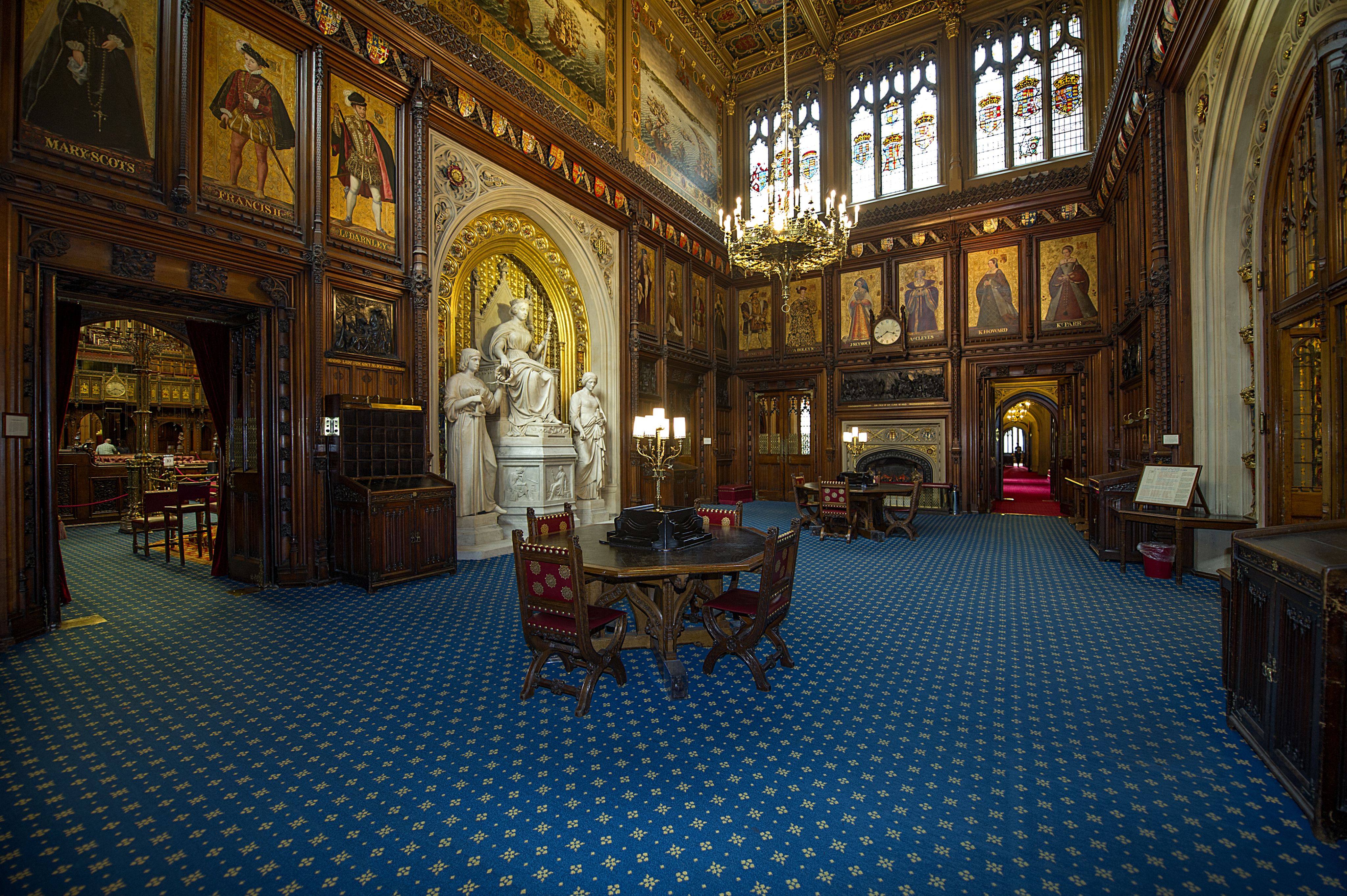65 years of the
Life Peerages Act 1958
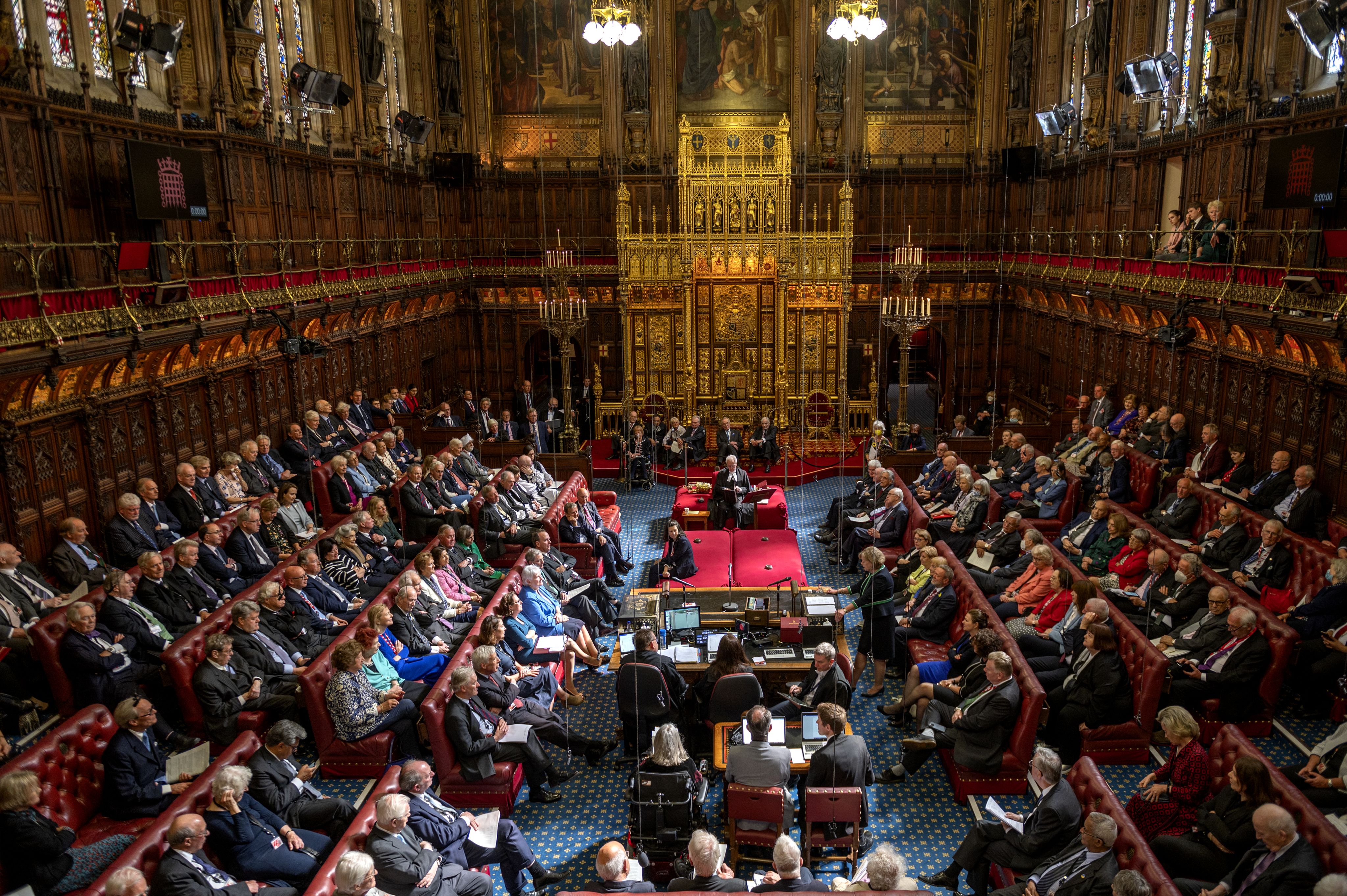
In July 65 years ago, the first life peers were announced following the passage of the Life Peerages Act 1958, paving the way for the first women members of the House of Lords alongside new members from a range of different backgrounds.
Scroll on to see artworks and items from Parliament's Archives and Heritage Collections that tell their story.

Introduction from the Lord Speaker
The introduction of life peerages in 1958 has a strong claim to be the most significant reform of the House of Lords in the course of the 20th century.
It transformed the Upper House from a largely moribund institution, with a daily attendance of 100 peers or fewer. It delivered an injection of fresh blood and intellectual vigour, in the form of peers appointed for their expertise in the realms of politics or business or science or the arts. And, not least, it allowed for the entry of women into what had previously been a men-only chamber.
Sixty-five years on, with the majority of hereditary peers removed in the reforms of 1999, the House is a forum for lively debate and rigorous scrutiny, benefiting from contributions from all sectors of the United Kingdom’s civil society. I view it as the nation’s finest thinktank.
The positive impact of the Life Peerages Act can be seen every day in the chamber. Among those now filling the red benches are doctors and diplomats, judges and journalists, charity workers, trade unionists, military officers and leaders of industry. Their deliberations play a huge part in increasing the quality of laws produced at Westminster.
Of course, there is more to be done. Fewer than one-third of members are women and only one in 14 comes from an ethnic minority background. But there is no doubt that the arrival of life peers improved our Parliament 65 years ago and that their presence in the chamber enhances the governance of our nation today.
Lord McFall of Alcluith
Lord Speaker
About the House of Lords
The House of Lords is an essential part of the UK Parliament. As the second chamber, it is independent from and complements the work of the elected House of Commons.
The House of Lords has three main functions within Parliament:
- to work with the Commons to shape new laws
- to raise concerns and challenge the work of the government through questions and debates
- to investigate public policy issues in committees.
Improving laws
The Lords plays a crucial role in the process of examining bills and approving new laws. Members debate the main principles of bills, scrutinise their content line by line and suggest improvements. Over 60 per cent of members’ time in the chamber is spent considering draft laws. Their work helps to ensure all new laws are well drafted, effective and workable.
Scrutinising and challenging
The Lords holds the government to account for its decisions and actions through questions and debates in the chamber, where government ministers must respond. If a particular event is happening, like a foreign war or health crisis, the Lords can ask the government what they propose to do.
Investigating issues
The House of Lords examines important areas of public policy through its select committees. Members use their professional experience to carry out investigative, subject-focused work, provoking discussion outside Parliament and making recommendations to the government.
Find out more about recent work of the House of Lords at www.parliament.uk/Lords.
Members and the Life Peerages Act 1958
The Life Peerages Act
On 30 April 1958, the Life Peerages Act was passed and introduced the ability to grant membership of the House of Lords for a specific person’s lifetime rather than on a hereditary basis. This also enabled women to become members of the House for the first time.
Proposals for creating life peers that were proposed by the government and appointed by the monarch had been around since the mid-nineteenth century. While some judges were already appointed for life (and the Lords Spiritual only retain their places while in office) it wasn’t until the introduction of a Life Peerages Bill in 1957 and then Royal Assent the following year that this was extended to other general membership of the Lords. The first life peers were announced on 24 July 1958.
Membership today
Members come from a wide range of backgrounds from across the UK, bringing their experience and expertise to their work in the House of Lords. Different social, political and professional backgrounds, and most faiths and ethnic groups in the UK are represented.
Most members are life peers. Many have a political background; some don’t. There are doctors, nurses, soldiers, technology experts, entrepreneurs, scientists, writers, judges, lawyers and police officers. Some members are chosen from communities for making a difference through involvement with charitable, voluntary and civil society organisations.
The House of Lords is known for its independence of thought and in-depth consideration of public policy. Backbench members who belong to political parties are not subject to the same level of discipline as in the Commons. There is also a large proportion of members who are not party-political, including the crossbenchers and bishops. Members also work on issues that concern them rather than on behalf of a particular geographic constituency. Some members have described these factors as enabling them to take a ‘long view’ of issues.
Today there are about 800 members who are eligible to take part in the work of the House of Lords. There is no upper limit on membership and numbers in each party and group fluctuate. The size of the House and appointment process for members are often a topic for debate.
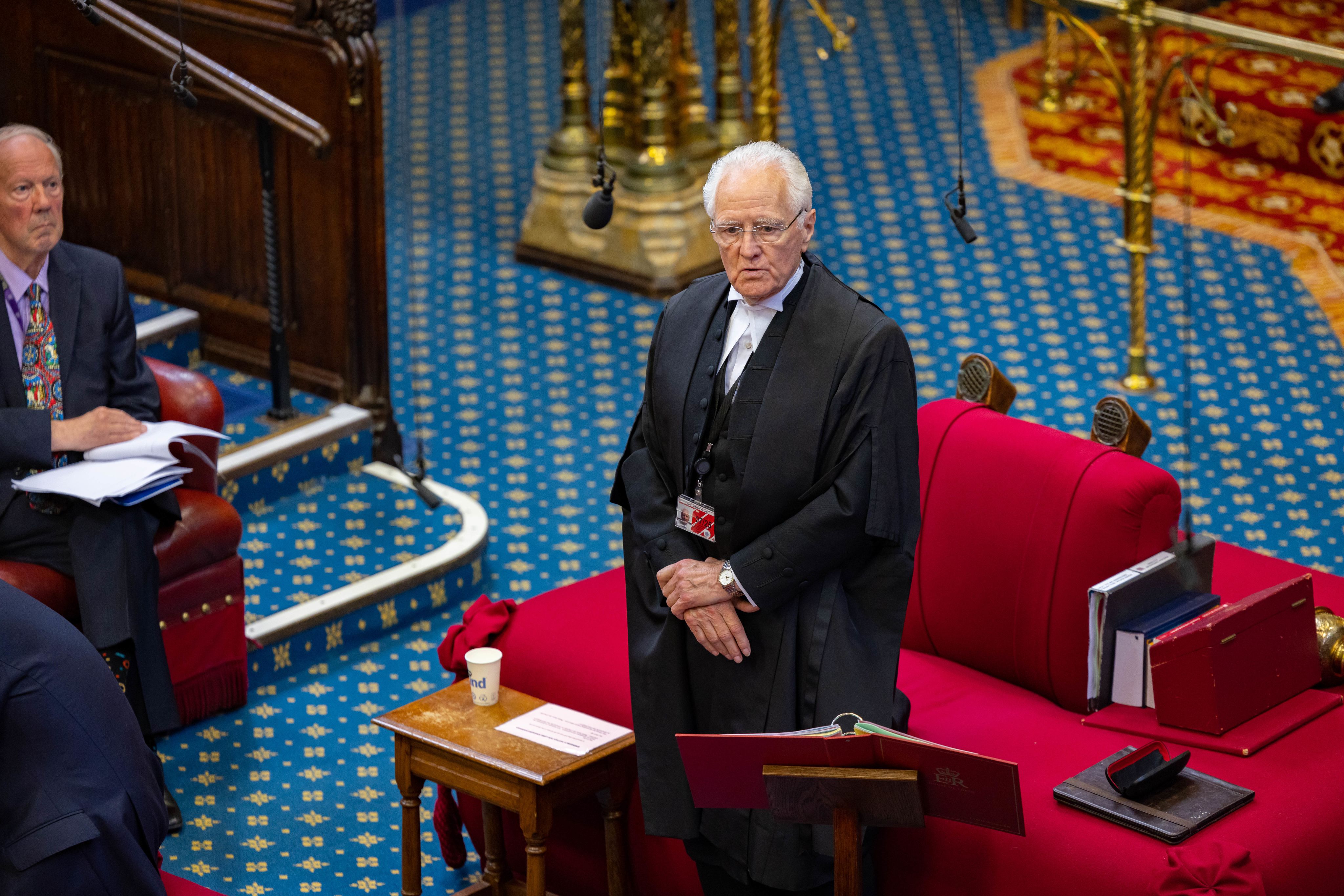
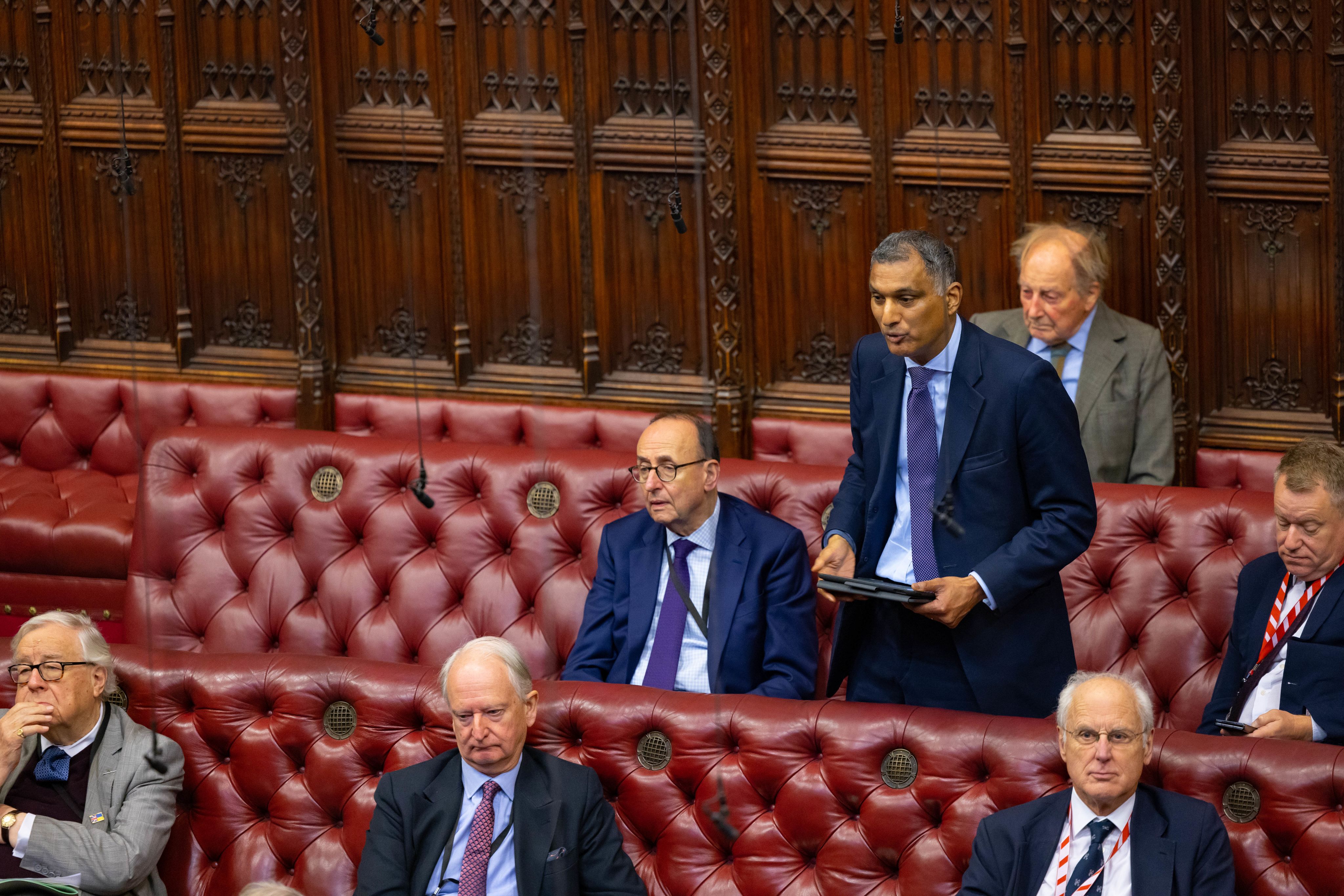
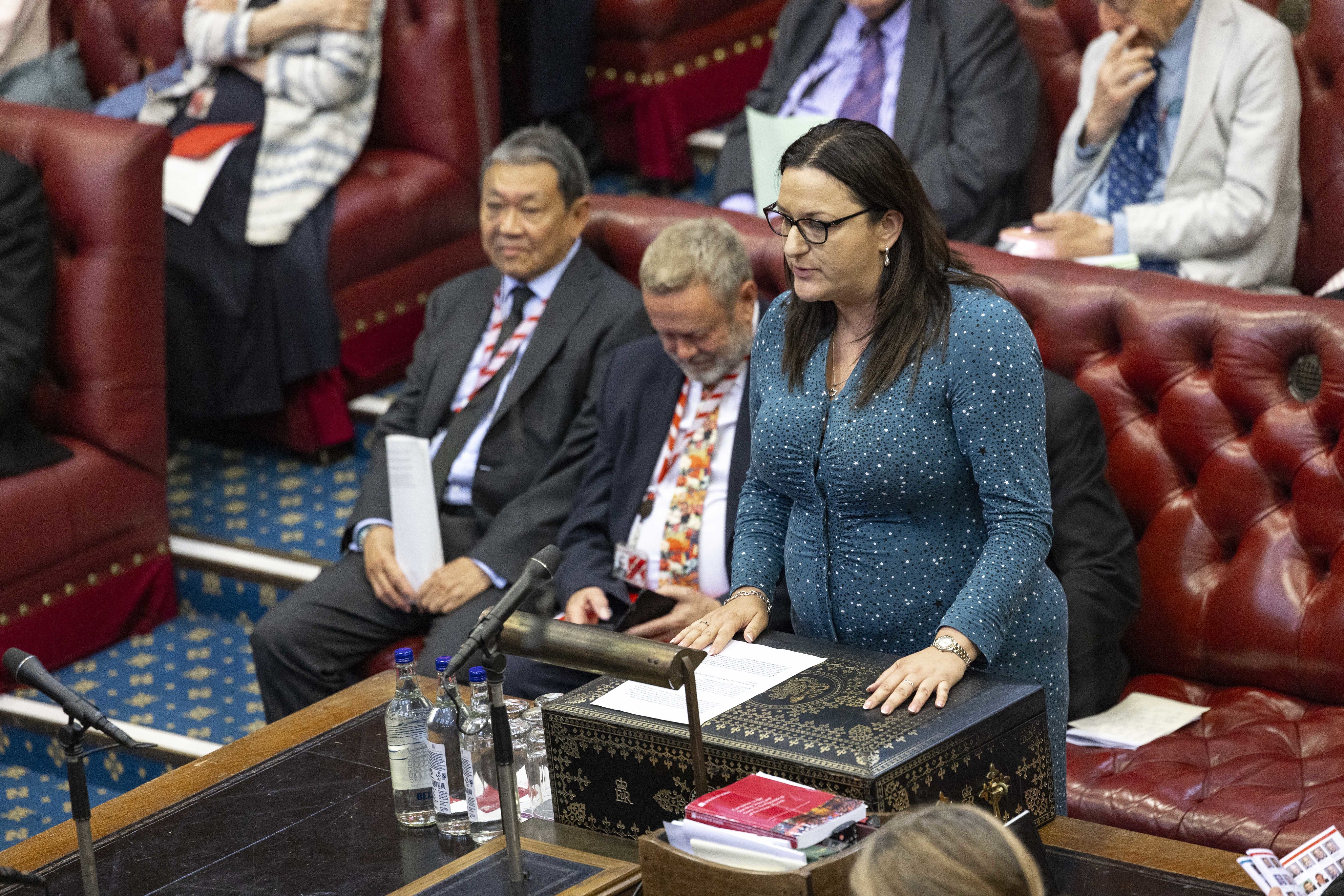
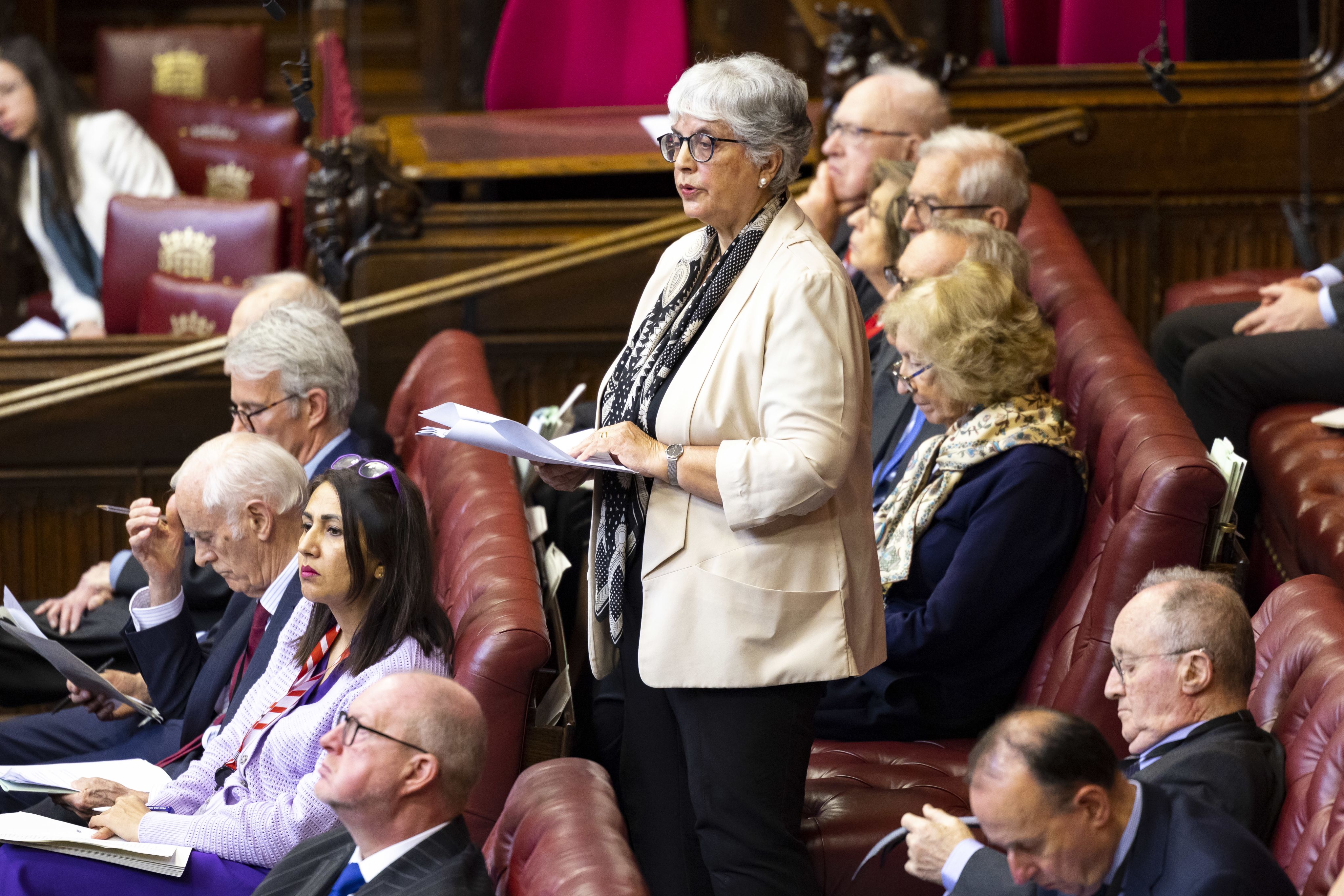
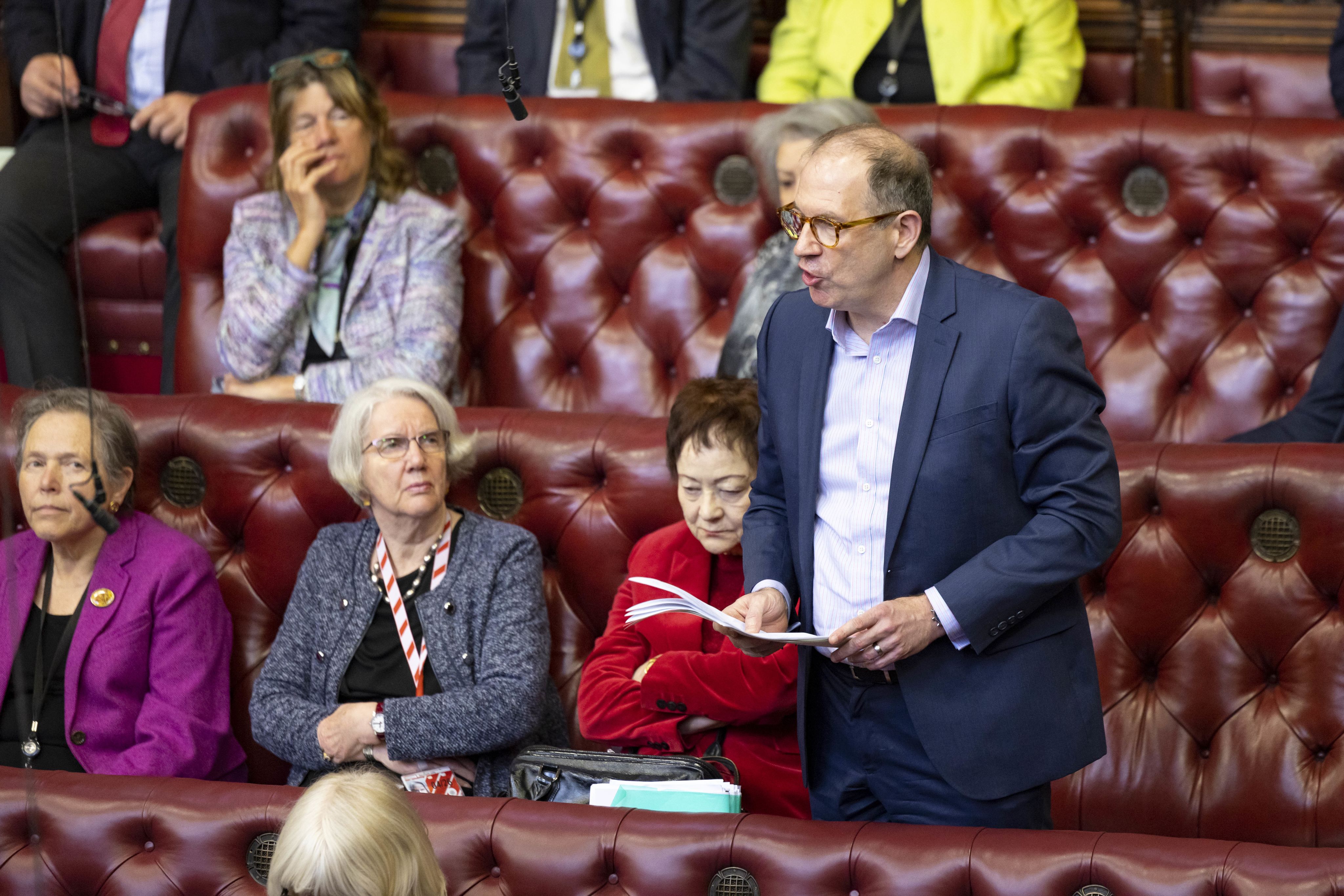
Introduction from the Lord Speaker
The introduction of life peerages in 1958 has a strong claim to be the most significant reform of the House of Lords in the course of the 20th century.
It transformed the Upper House from a largely moribund institution, with a daily attendance of 100 peers or fewer. It delivered an injection of fresh blood and intellectual vigour, in the form of peers appointed for their expertise in the realms of politics or business or science or the arts. And, not least, it allowed for the entry of women into what had previously been a men-only chamber.
Sixty-five years on, with the majority of hereditary peers removed in the reforms of 1999, the House is a forum for lively debate and rigorous scrutiny, benefiting from contributions from all sectors of the United Kingdom’s civil society. I view it as the nation’s finest thinktank.
The positive impact of the Life Peerages Act can be seen every day in the chamber. Among those now filling the red benches are doctors and diplomats, judges and journalists, charity workers, trade unionists, military officers and leaders of industry. Their deliberations play a huge part in increasing the quality of laws produced at Westminster.
Of course, there is more to be done. Fewer than one-third of members are women and only one in 14 comes from an ethnic minority background. But there is no doubt that the arrival of life peers improved our Parliament 65 years ago and that their presence in the chamber enhances the governance of our nation today.
Lord McFall of Alcluith
Lord Speaker

About the House of Lords
The House of Lords is an essential part of the UK Parliament. As the second chamber, it is independent from and complements the work of the elected House of Commons.
The House of Lords has three main functions within Parliament:
- to work with the Commons to shape new laws
- to raise concerns and challenge the work of the government through questions and debates
- to investigate public policy issues in committees.
Improving laws
The Lords plays a crucial role in the process of examining bills and approving new laws. Members debate the main principles of bills, scrutinise their content line by line and suggest improvements. Over 60 per cent of members’ time in the chamber is spent considering draft laws. Their work helps to ensure all new laws are well drafted, effective and workable.
Scrutinising and challenging
The Lords holds the government to account for its decisions and actions through questions and debates in the chamber, where government ministers must respond. If a particular event is happening, like a foreign war or health crisis, the Lords can ask government what they propose to do.
Investigating issues
The House of Lords examines important areas of public policy through its select committees. Members use their professional experience to carry out investigative, subject-focused work, provoking discussion outside Parliament and making recommendations to government.
Find out more about recent work of the House of Lords at www.parliament.uk/Lords.


Members and the Life Peerages Act 1958
The Life Peerages Act
On 30 April 1958, the Life Peerages Act was passed and introduced the ability to grant membership of the House of Lords for a specific person’s lifetime rather than on a hereditary basis. This also enabled women to become members of the House for the first time.
Proposals for creating life peers that were proposed by the government and appointed by the monarch had been around since the mid-nineteenth century. While some judges were already appointed for life (and the Lords Spiritual only retain their places while in office) it wasn’t until the introduction of a Life Peerages Bill in 1957 and then Royal Assent the following year that this was extended to other general membership of the Lords. The first life peers were announced on 24 July 1958.
Membership today
Members come from a wide range of backgrounds from across the UK, bringing their experience and expertise to their work in the House of Lords. Different social, political and professional backgrounds, and most faiths and ethnic groups in the UK are represented.
Most members are life peers. Many have a political background; some don’t. There are doctors, nurses, soldiers, technology experts, entrepreneurs, scientists, writers, judges, lawyers and police officers. Some members are chosen from communities for making a difference through involvement with charitable, voluntary and civil society organisations.
The House of Lords is known for its independence of thought and in-depth consideration of public policy. Backbench members who belong to political parties are not subject to the same level of discipline as in the Commons. There is also a large proportion of members who are not party-political, including the crossbenchers and bishops. Members also work on issues that concern them rather than on behalf of a particular geographic constituency. Some members have described these factors as enabling them to take a ‘long view’ of issues.
Today there are about 800 members who are eligible to take part in the work of the House of Lords. There is no upper limit on membership and numbers in each party and group fluctuate. The size of the House and appointment process for members are often a topic for debate.


The first women members
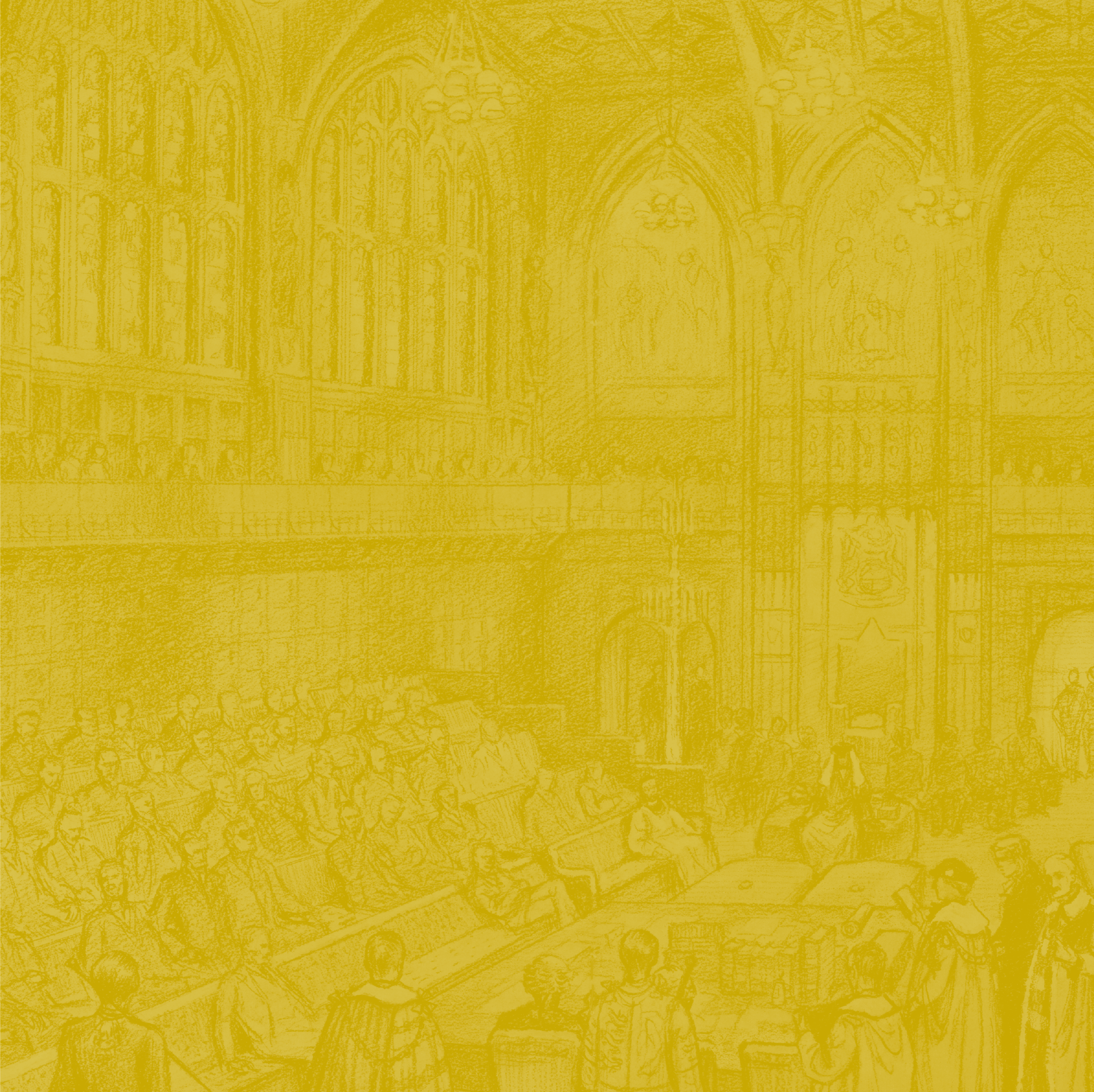
Baroness Wootton of Abinger
Baroness Wootton became the first woman life peer on 8 August 1958 when her letters patent (the formal document that creates a peerage) were sealed. She was also the first woman to chair proceedings in the Lords as a Deputy Speaker. Baroness Wootton was an expert on sociology, criminology and penal reform and is recognised for sponsoring the bill to abolish the death penalty in 1965.
Pictured is a letter from Baroness Wootton to members of the Lords encouraging them to support the bill to abolish the death penalty. The letter is currently held in the Parliamentary Archives.
Letter from Baroness Wootton to members of the House of Lords, 8 July 1965, Parliamentary Archives, LH/1/74
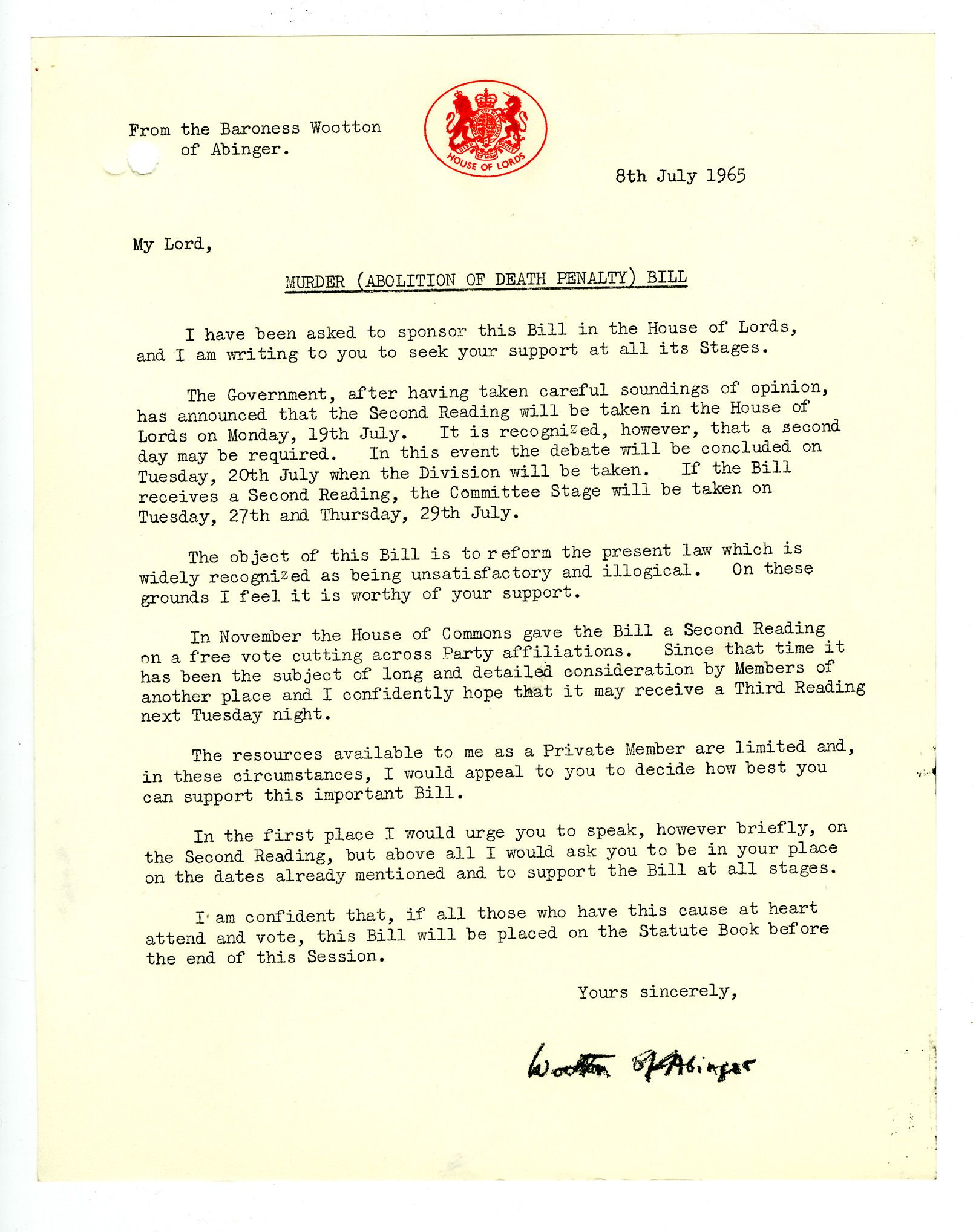
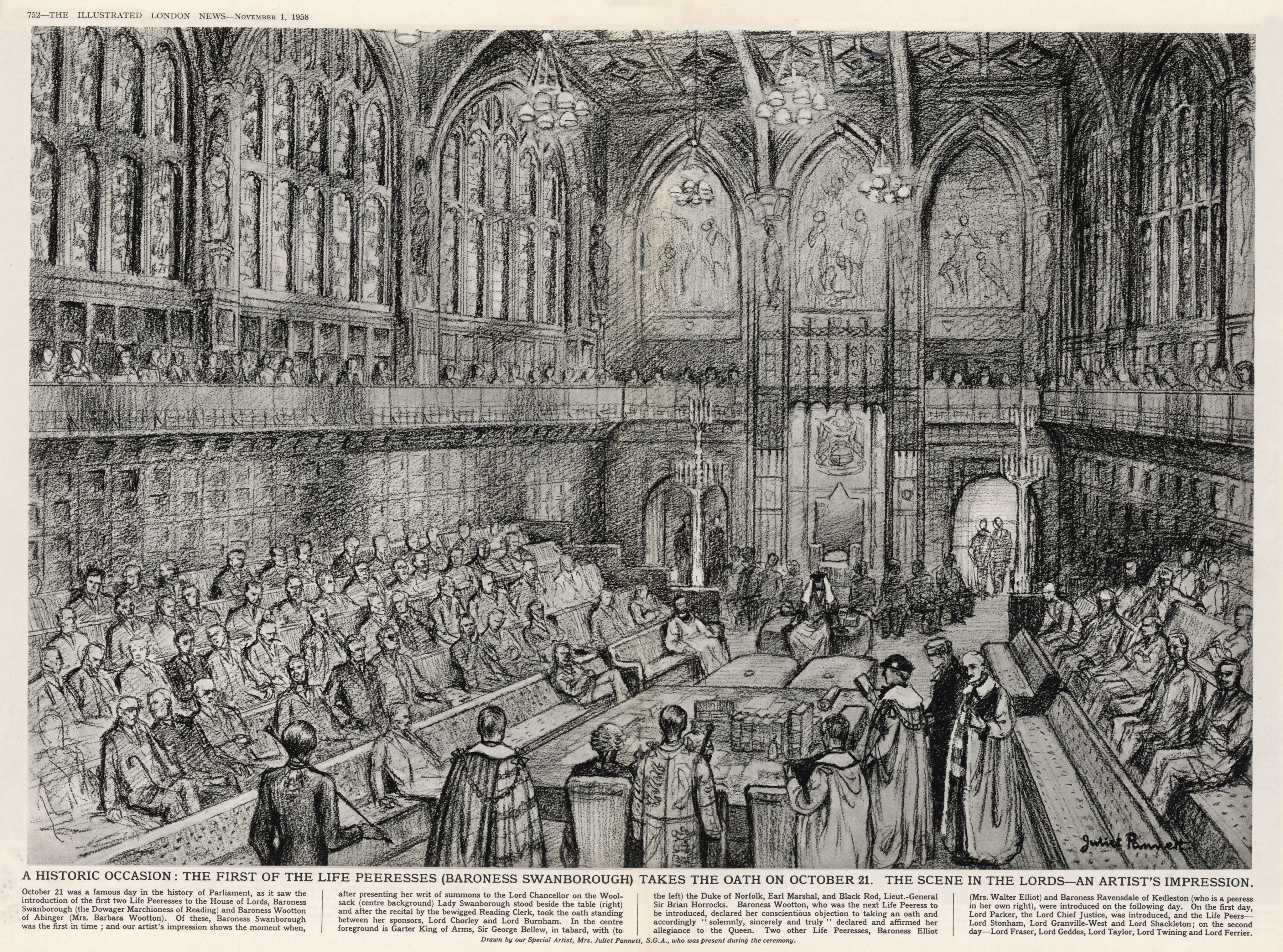
Baroness Swanborough
Baroness Swanborough became the first woman to take her seat in the House of Lords in October 1958. Baroness Swanborough founded the Women’s Voluntary Service, which supported refugees, bombing victims and the armed forces during the Second World War. Later, she chaired the Advisory Council on Commonwealth Immigration and played a leading role in facilitating Windrush.
Pictured is an illustration of Baroness Swanborough taking the oath in the House of Lords chamber.
An illustration of Baroness Swanborough taking the oath, © Mary Evans Picture Library
Baroness Elliot of Harwood
Baroness Elliot was the first woman to speak in the Lords as a member of the House on 4 November 1958. She was known for her longstanding work on prison reform, childcare, consumer affairs and refugees. She also became the first woman to guide a private members’ bill through the House of Lords.
Pictured is Baroness Elliot of Harwood speaking at the Conservative Party conference in 1961. This photo is held in the Parliamentary Archives.
Baroness Elliot of Harwood, 12 Oct 1961, Parliamentary Archives, PUD/F/534
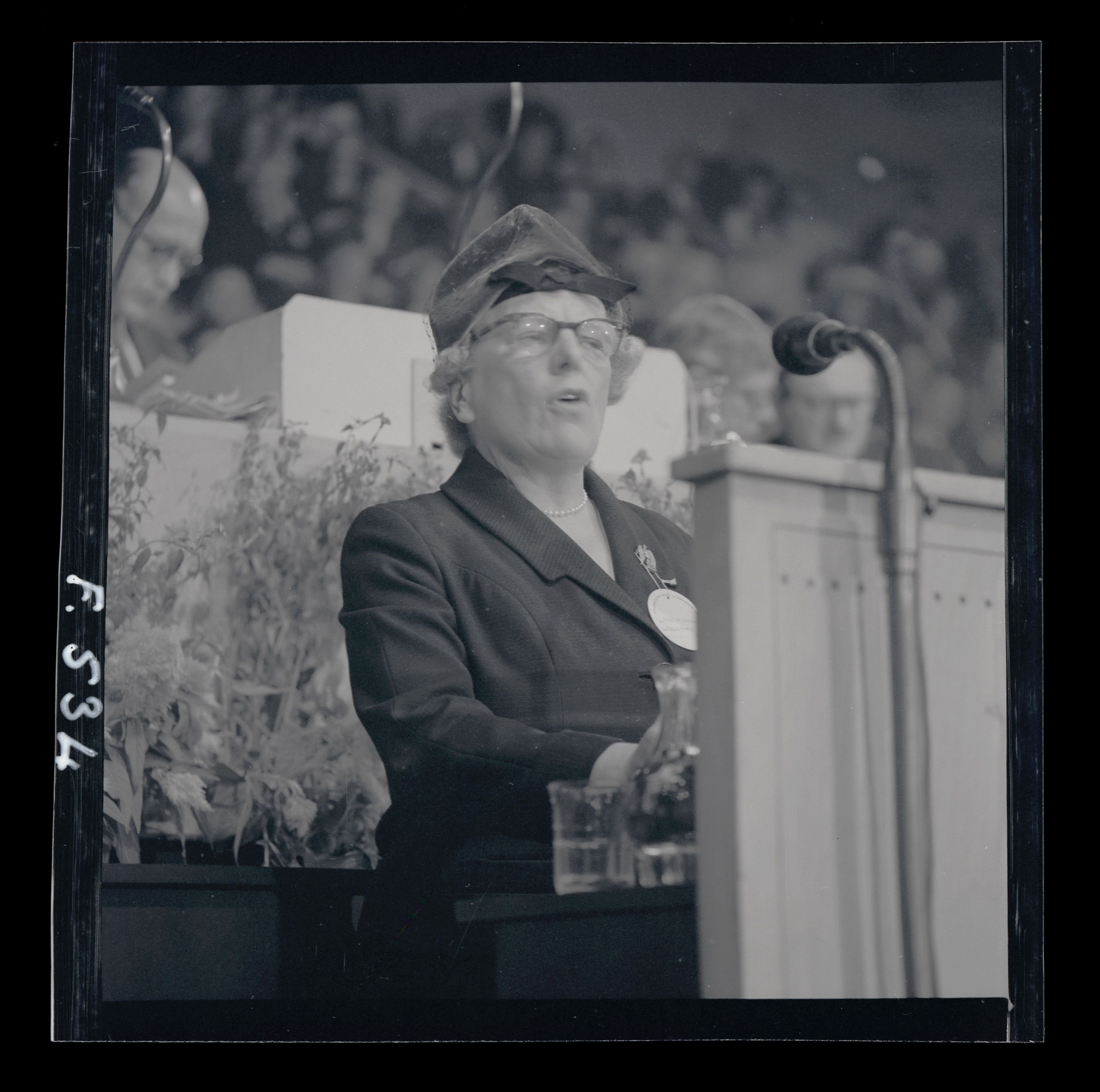
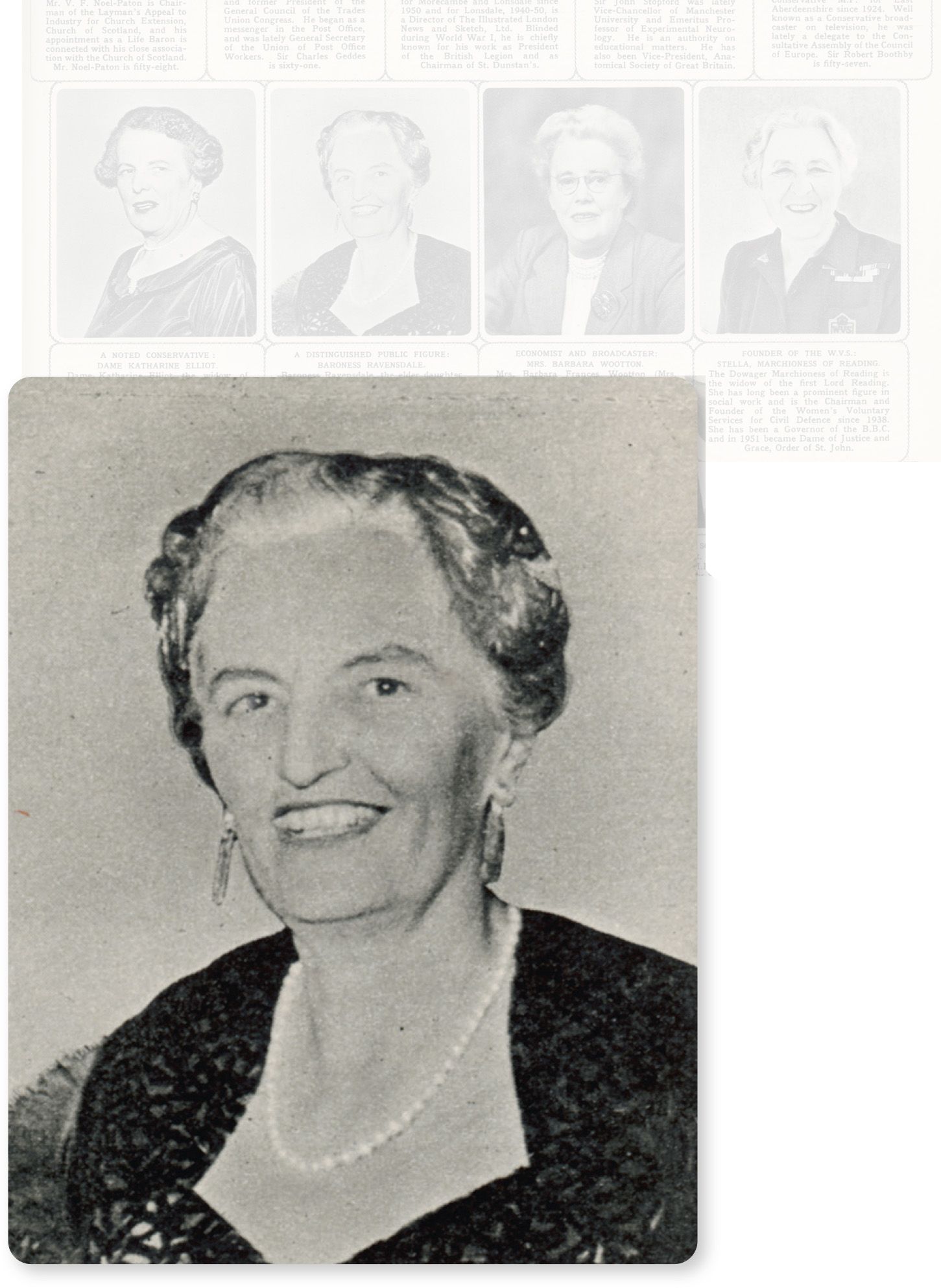
Baroness Ravensdale of Kedleston
Baroness Ravensdale was a hereditary peer in her own right but unable to take her seat as a woman. She was awarded a life peerage in 1958 for her work with young people and is recognised for criticising the double standards for men and women in the 1959 Street Offences Bill.
Baroness Ravensdale (pictured here) and the other members appointed in the group of first life peerages were featured in an article in The Illustrated London News on 2 August 1958.
Baroness Ravensdale appears in an article on the first life peers in The Illustrated London News, 2 August 1958, © Mary Evans Picture Library
The 1960s
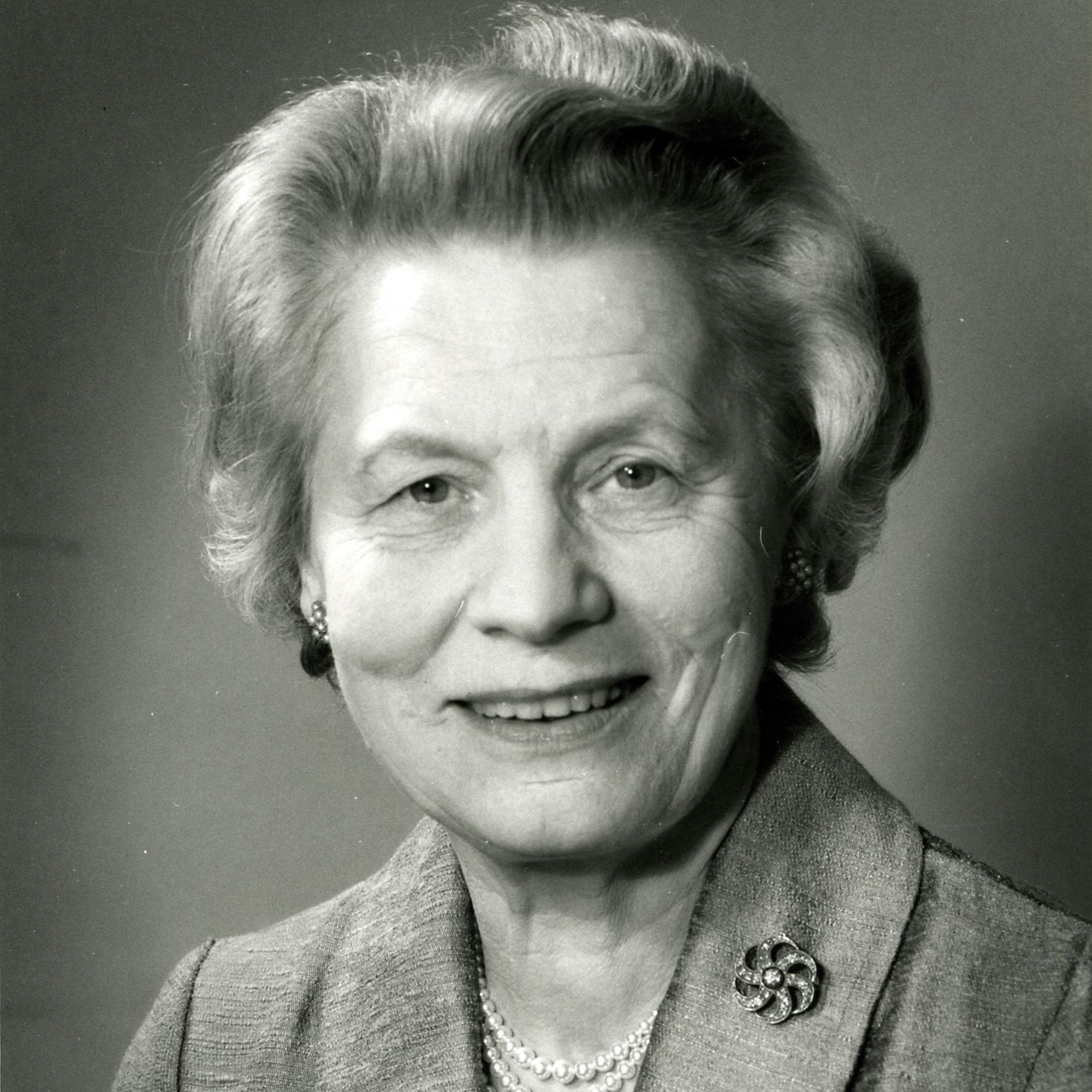
Baroness Summerskill
Baroness Summerskill was a doctor and politician and the fifth woman life peer to be appointed, having served as an MP for more than 20 years previously. Baroness Summerskill had already spoken at the despatch box in the Lords by the time she was appointed a Baroness, as she had been an MP during the time the Commons occupied the Lords chamber following the bombing of the House of Commons in the Second World War.
Baroness Summerskill was a renowned campaigner for women’s rights to equal opportunities and meaningful careers. In the Lords she successfully campaigned for changes to the property rights of housewives and divorced women. She also worked on the legalisation of abortion and homosexual law reform.
Baroness Summerskill, 21 June 1966, Parliamentary Archives, PUD/14/686
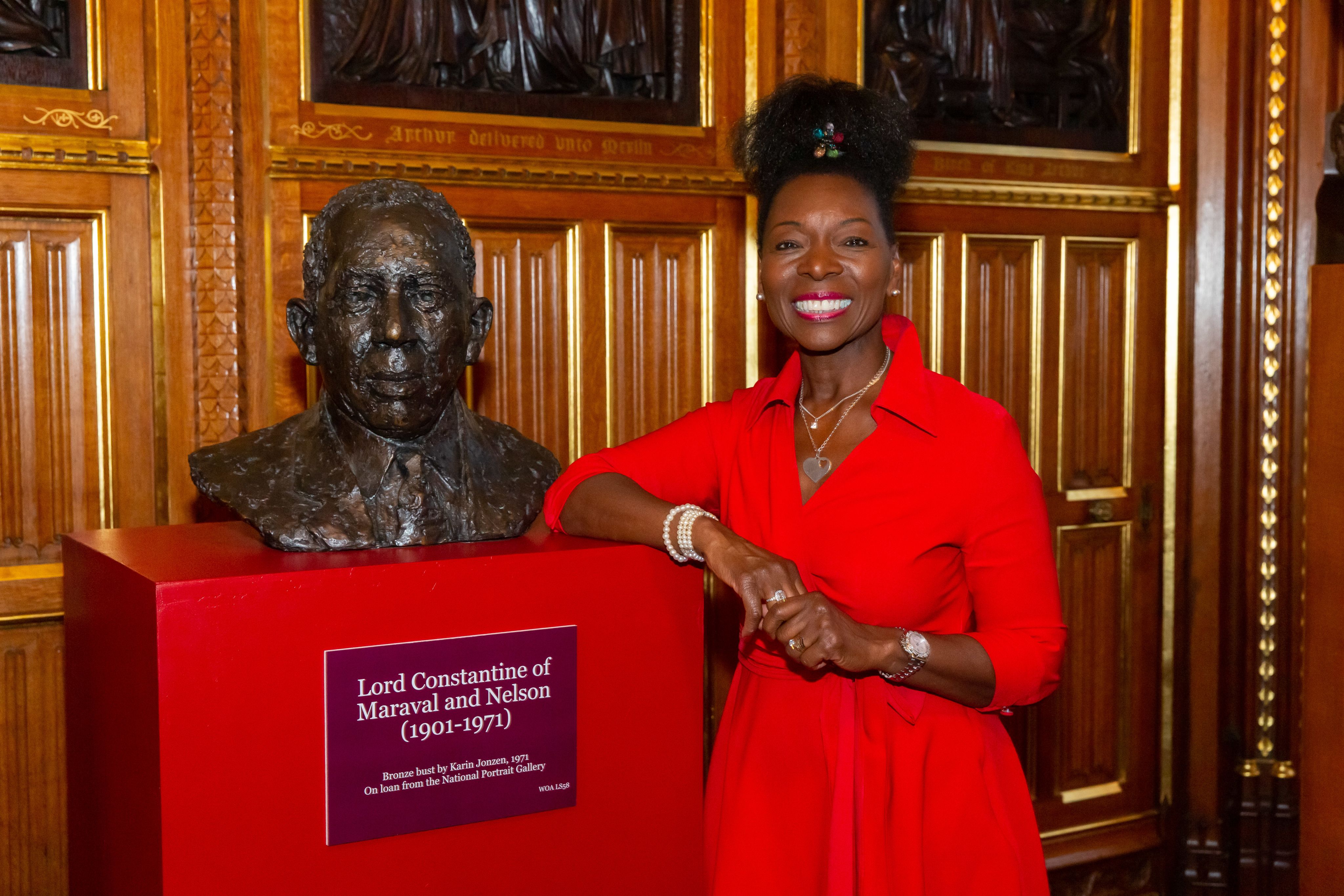
Lord Constantine
‘I think it must have been for what I have endeavoured to do, to make it possible for people of different colour to know each other better and live well together.’
Trinidadian cricketer, barrister and campaigner against racial injustice, Lord Constantine became the first Black member of the House of Lords in 1969.
Earlier in Lord Constantine’s life, he played test cricket for the West Indies and spent his first-class career playing in England. He then returned to Trinidad and published the book Colour Bar, which examined racial prejudice and discrimination around the world. He later returned to the UK as the first High Commissioner for Trinidad and Tobago, became a governor of the BBC and a member of the Race Relations Board before becoming a life peer.
Baroness Benjamin stands next to a bronze bust of Learie Constantine by Karin Jonzen, on loan to the House of Lords from the National Portrait Gallery, photograph by Roger Harris
The 1970s
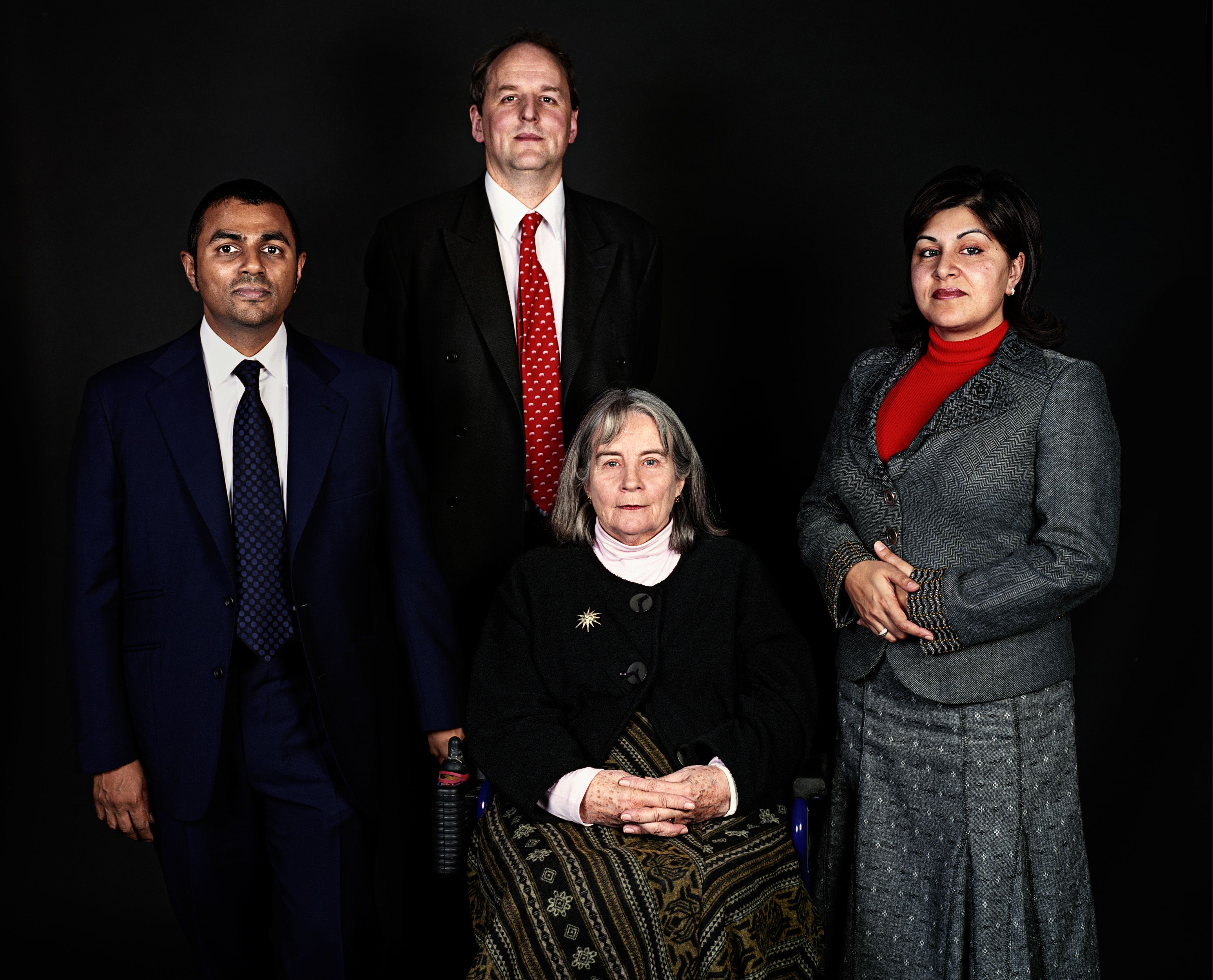
Baroness Masham of Ilton
Baroness Masham was appointed a life peer in 1970 and became the longest serving woman member of the House of Lords. She was one of the first ever Paralympic medallists for Great Britain and described by Paralympics GB as a ‘pioneering athlete’, having competed in the first Games in Rome in 1960. During her Paralympic career, Baroness Masham competed in three Games and won multiple gold, silver and bronze medals in swimming and table tennis.
Baroness Masham was a dedicated campaigner for disability rights. She founded the Spinal Injuries Association in the 1970s and gave her maiden speech, the first speech by a new member, in the House of Lords on the Chronically Sick and Disabled Persons Bill, which became the first piece of legislation to give rights to people with disabilities.
Baroness Masham is pictured centre in this portrait, taken as part of a series to mark 50 years of life peerages. The members featured were the youngest members in their parties or groupings at the time of the photo.
Youngest Peers: Baroness Warsi, Lord Redesdale, Lord Alli and Baroness Masham of Ilton, photograph by Desiree Pfeiffer, © UK Parliament, WOA 6908 heritagecollections.parliament.uk
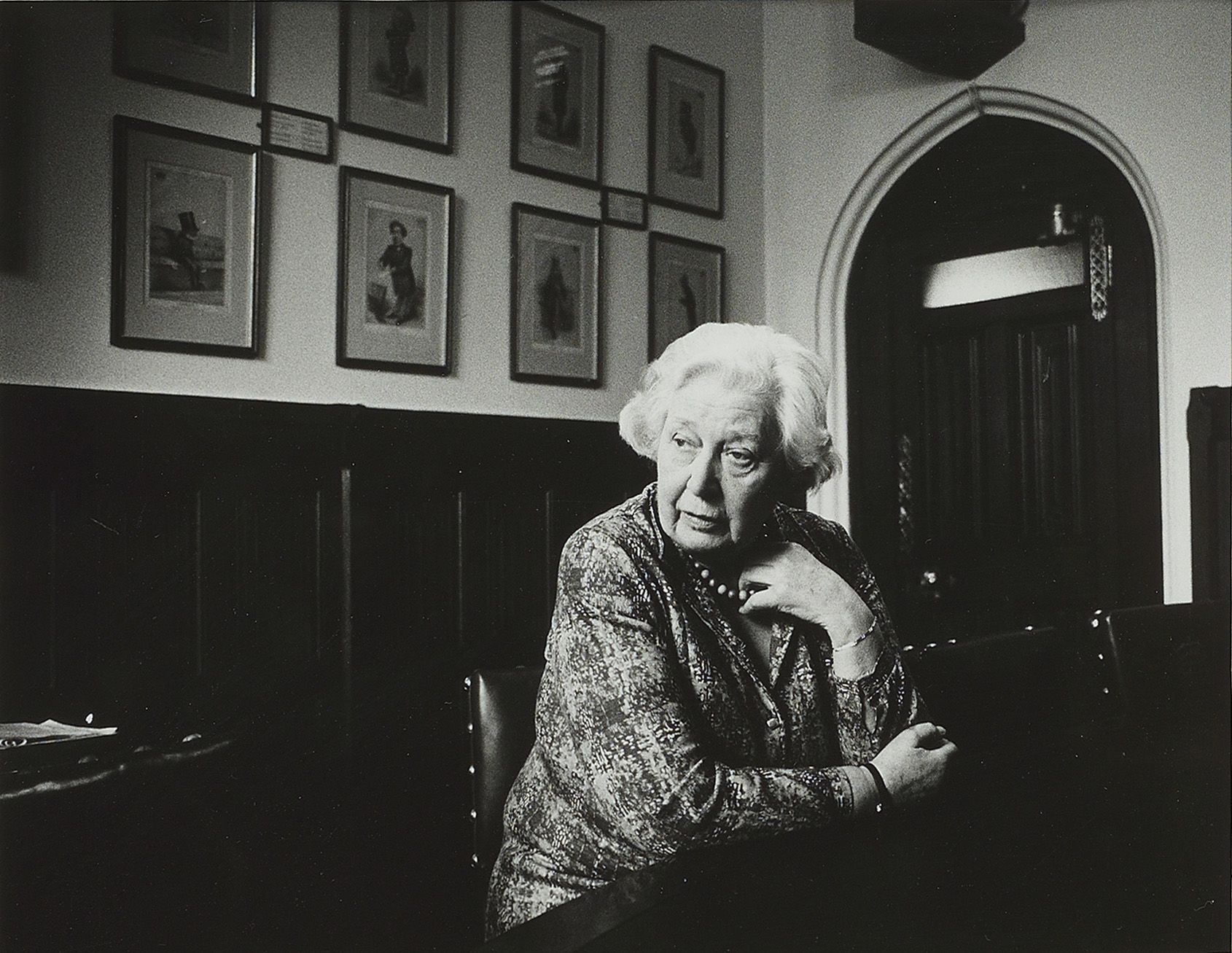
Baroness Seear of Paddington
Appointed to the House of Lords in 1971, Baroness Seear was a leading campaigner for the rights of women and carers.
During her political career, she worked with, and often led, organisations such as the National Association for Care and Resettlement of Offenders, the National Carers' Association, the National Council for the Single Woman and her Dependants, and the Fawcett Society.
In 1973, Baroness Seear sponsored the Sex Discrimination Bill in the House of Lords and, in 1981, chaired a select committee on unemployment. She also served as leader of the Liberal Party in the Lords and deputy leader of the Liberal Democrats.
Baroness Seear of Paddington, 1913-1997, Leader of the Liberal Peers, 1984-1988, photograph by unknown, © UK Parliament, WOA 6023 heritagecollections.parliament.uk
The 1980s
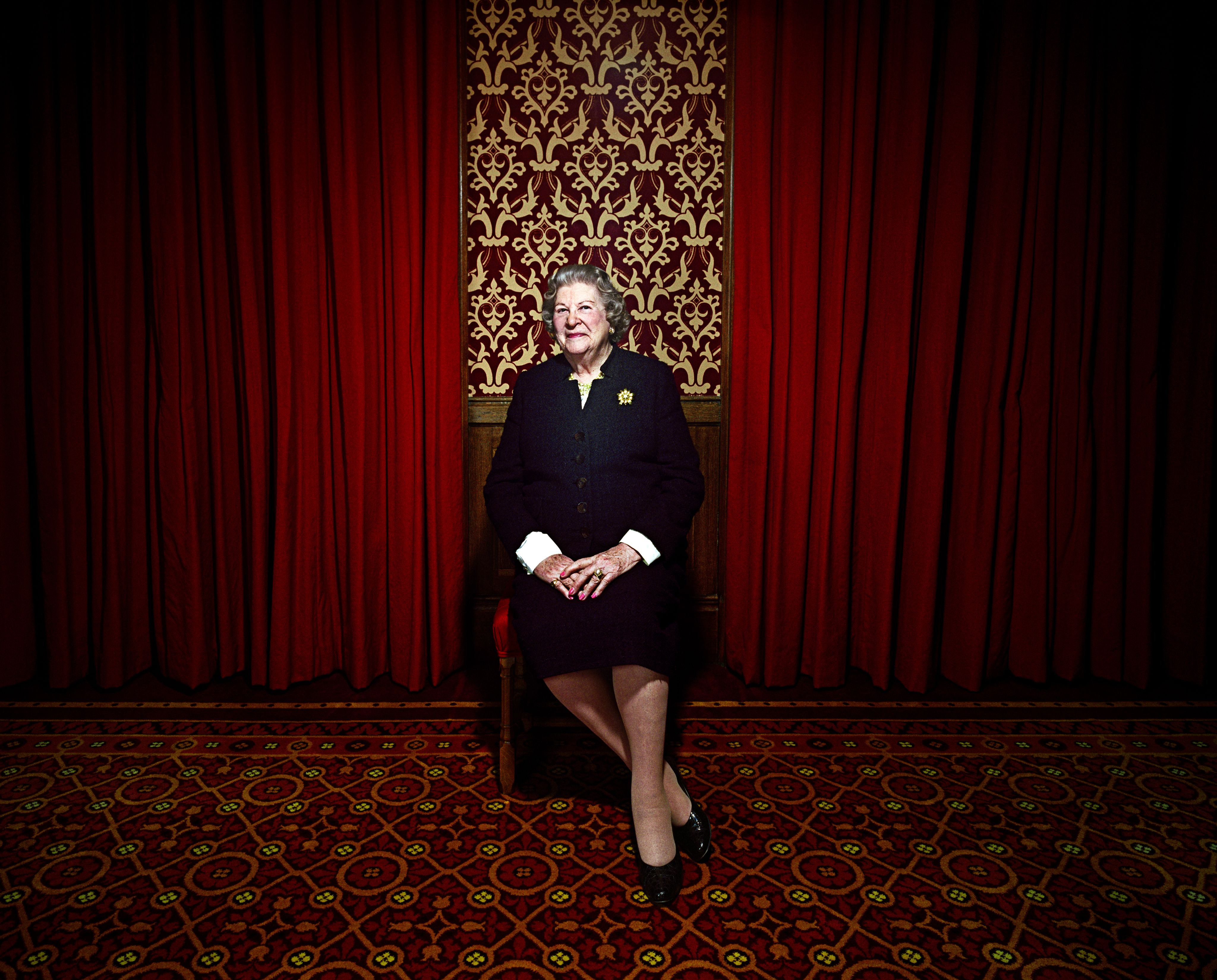
Baroness Trumpington
Baroness Trumpington was appointed to the House of Lords in 1980, serving in several ministerial roles under Prime Ministers Margaret Thatcher and John Major. During this time, she also served as a government whip.
Baroness Trumpington had an extensive career before she arrived in the Lords, including working in naval intelligence at Bletchley Park during World War Two. Later, she was appointed to the United Nations Commission on the Status of Women. During her time in the Lords, Baroness Trumpington was involved with a number of causes including prisons, mental health, rural affairs and the bill prohibiting female genital mutilation. She also supported the campaign to posthumously pardon Alan Turing.
Baroness Trumpington is pictured here in the Palace of Westminster. This photograph comes from a series commissioned to commemorate the 50th anniversary of the Life Peerages Act of 1958. The photographs show a cross-section of Life Peers at work in 2007 (WOAs 6908-6922) and was the House’s first photography commission.
Baroness Trumpington, photograph by Desiree Pfeiffer, © UK Parliament, WOA 6919 heritagecollections.parliament.uk
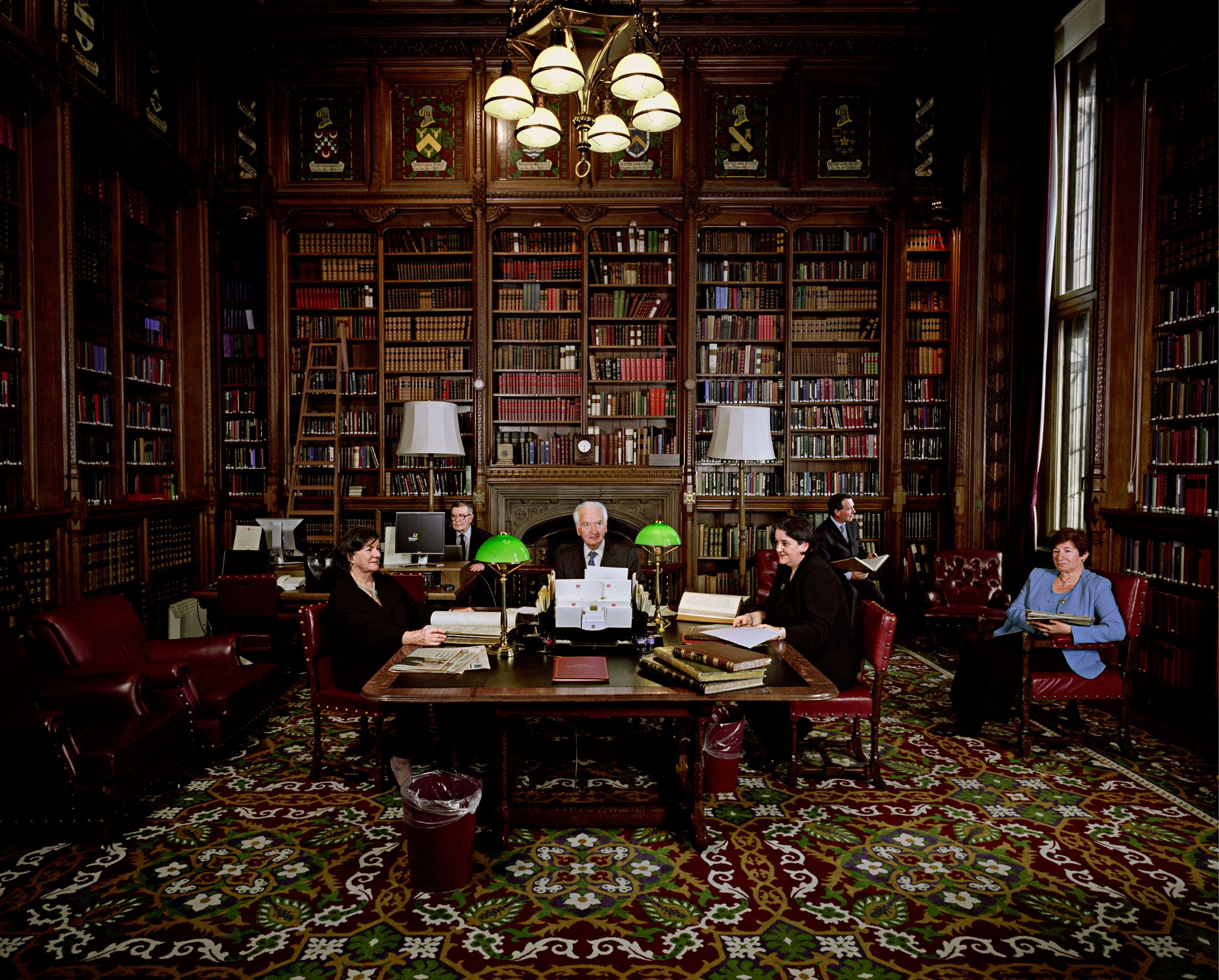
Lord Mackay of Clashfern
Lord Mackay served as a member of the House of Lords from 1979 until his retirement in 2022. He is a prominent lawyer, having served as Lord Advocate, the chief legal adviser to the government on Scottish matters.
Lord Mackay later served as Lord Chancellor for almost a decade when the role involved presiding over business in the House of Lords, before the role of Lord Speaker was created, as well as representing the judiciary in the Cabinet.
Lord Mackay is pictured centre in this portrait taken in the House of Lords Library. The members pictured had taken part in an important debate on the Human Fertilisation and Embryology Bill.
Debate - Human Fertilisation and Embryology Bill: Lord MacKay of Clashfern, Lord Jenkin of Roding, Lord Alton of Liverpool, Baroness Tonge, Baroness Barker and Baroness Deech, photograph by Desiree Pfeiffer, © UK Parliament, WOA 6913 heritagecollections.parliament.uk
The 1990s to present
Baroness Amos
Appointed to the House of Lords in 1997, Baroness Amos became the first Black woman to serve in the Cabinet when she was appointed International Development Secretary, later serving as Leader of the House of Lords, the first Black person to hold the position.
Outside of the Lords, Baroness Amos has served as British High Commissioner to Australia, and played a leading role in the United Nations on emergency relief and humanitarian issues. Baroness Amos was the director of SOAS, University of London before becoming Master of University College, Oxford.
This portrait by artist Paul Benney was commissioned by the Lord Speaker’s Advisory Panel on Works of Art when she was Leader of the House of Lords and the Lord President of the Council. Benney is a celebrated self-taught portrait artist, exhibiting eight times at the BP Portrait Awards.
Baroness Amos, oil painting by Paul Benney,
© UK Parliament, WOA 6386 heritagecollections.parliament.uk
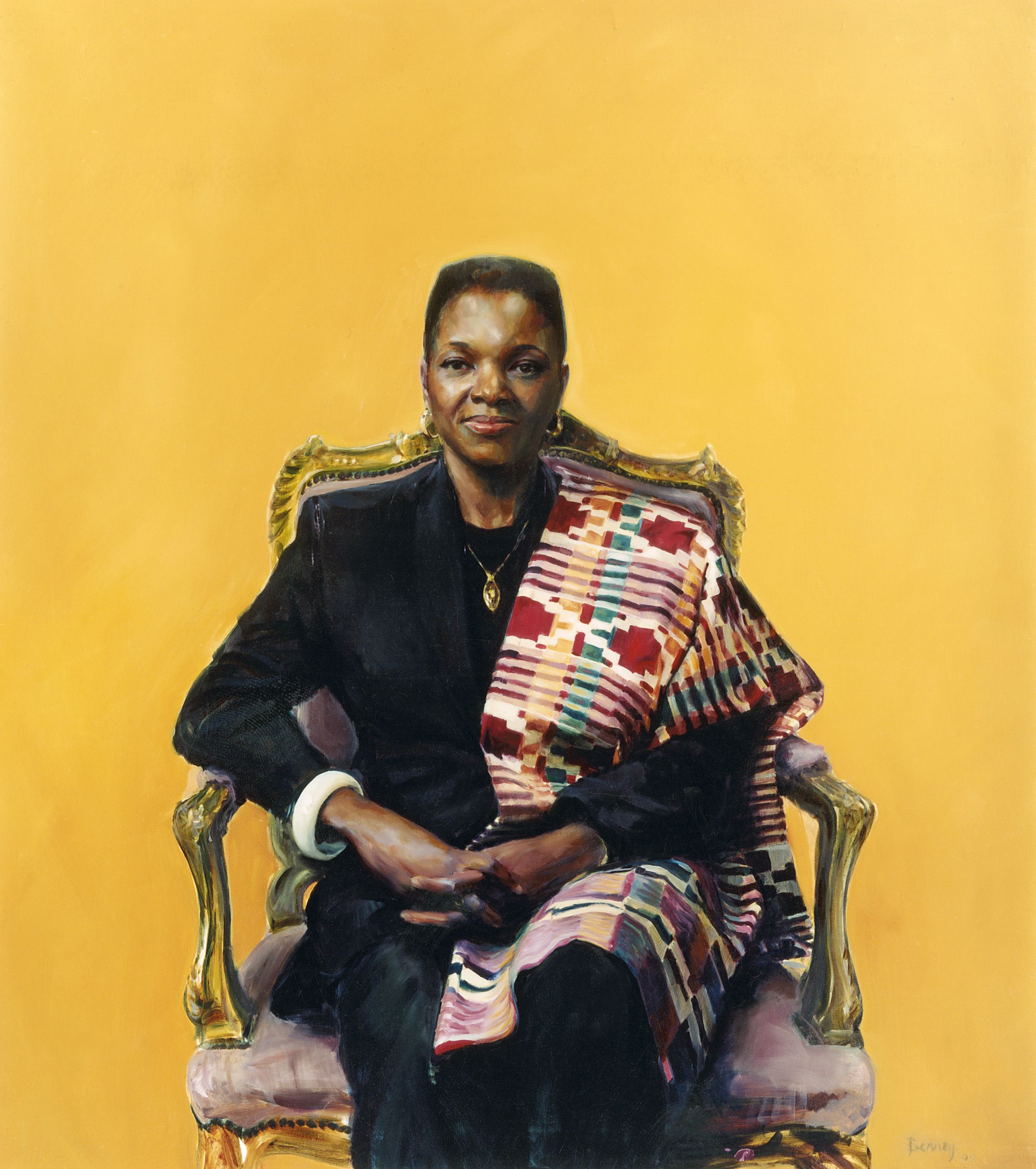
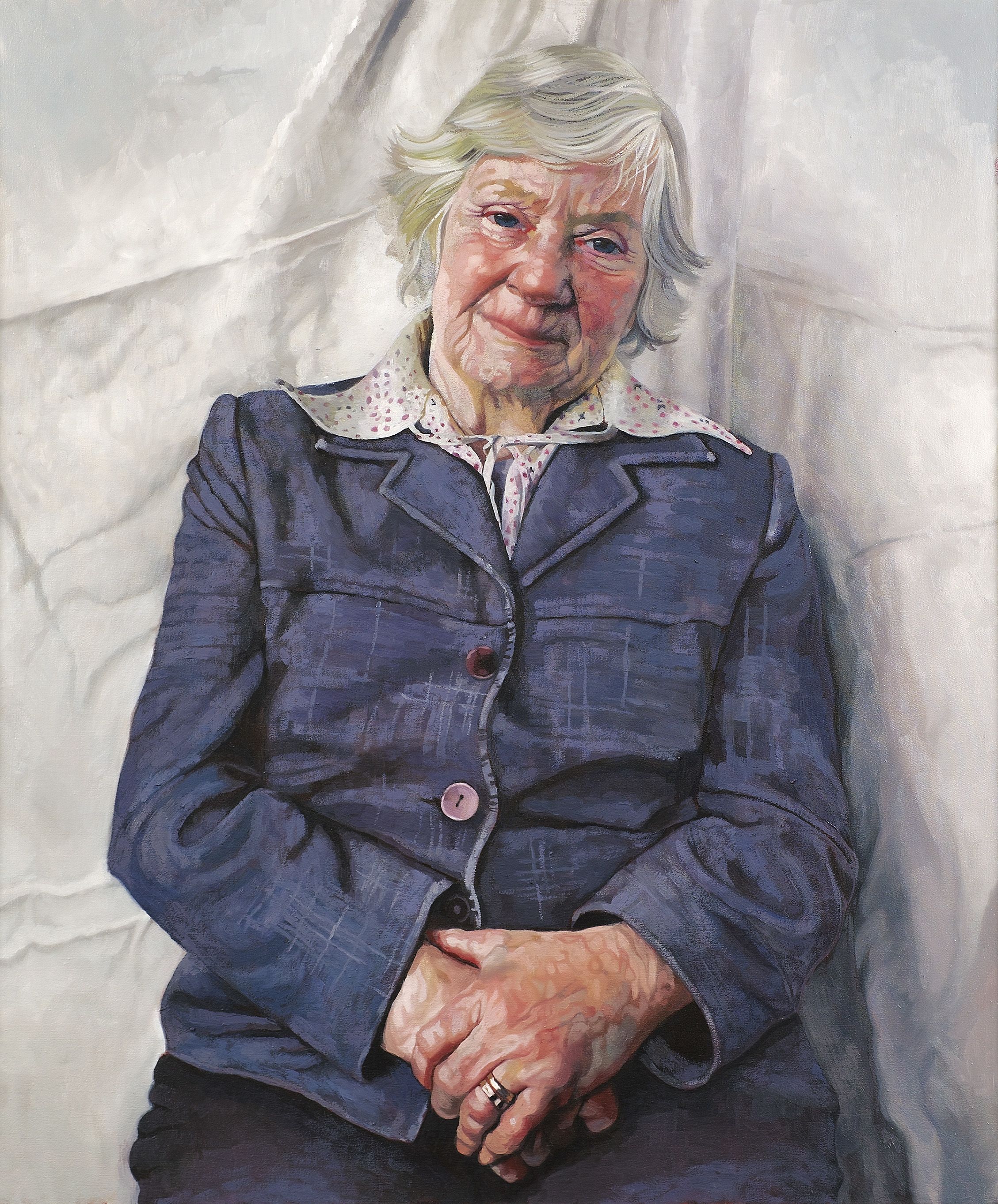
Baroness Williams of Crosby
One of the ‘Gang of Four’, Baroness Williams was a founding member of the Social Democratic Party, which later merged to become the Liberal Democrats. She served as an MP multiple times, for Labour and later the SDP, and was a member of the Cabinet in the 1970s.
Baroness Williams was appointed to the House of Lords in 1993 and subsequently served as leader of the Liberal Democrats in the House of Lords.
This portrait was commissioned by the Speaker’s Advisory Committee on Works of Art in 2007. The artist, Victoria Russell, completed the portrait in five months. Russell trained at central St Martins and the RA and won first prize at the BP Portrait Award in 2000. She has fulfilled several commissions of major politicians and leaders. In 2007 (the year of the commission), Gordon Brown had appointed Baroness Williams as an advisor on nuclear proliferation.
Baroness Williams of Crosby Shirley Williams, oil painting by Victoria Russell, © UK Parliament, WOA 6590 heritagecollections.parliament.uk
Lord Holmes of Richmond
A former Paralympian, Lord Holmes of Richmond regularly campaigns on issues around financial inclusion and including digital, data and financial literacy in education. He has campaigned on ensuring access to cash and successfully convinced the government to require cashback to be offered without a purchase. He also introduced a bill to ban unpaid internships and sponsored the British Sign Language Act 2022 during its passage through the Lords.
During his Paralympic career, Lord Holmes represented Great Britain at four Games, winning nine gold, five silver and a bronze medal. He is the only British Paralympic swimmer to win six gold medals at a single Games.
Lord Holmes was director of Paralympic Integration for the London Olympic Games before he was appointed to the House of Lords in 2013.
Lord Holmes of Richmond speaking in the House of Lords chamber, photograph by Roger Harris
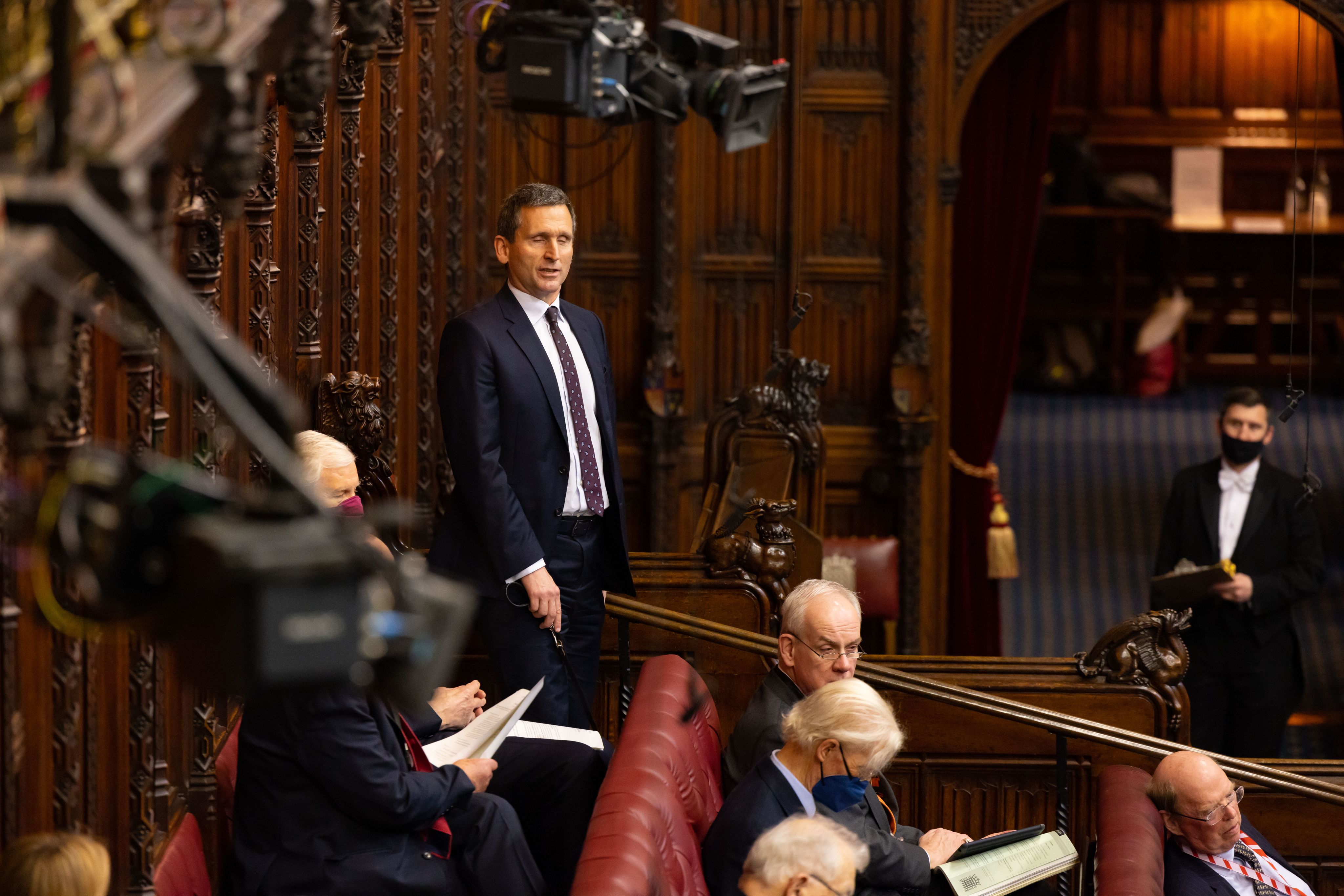
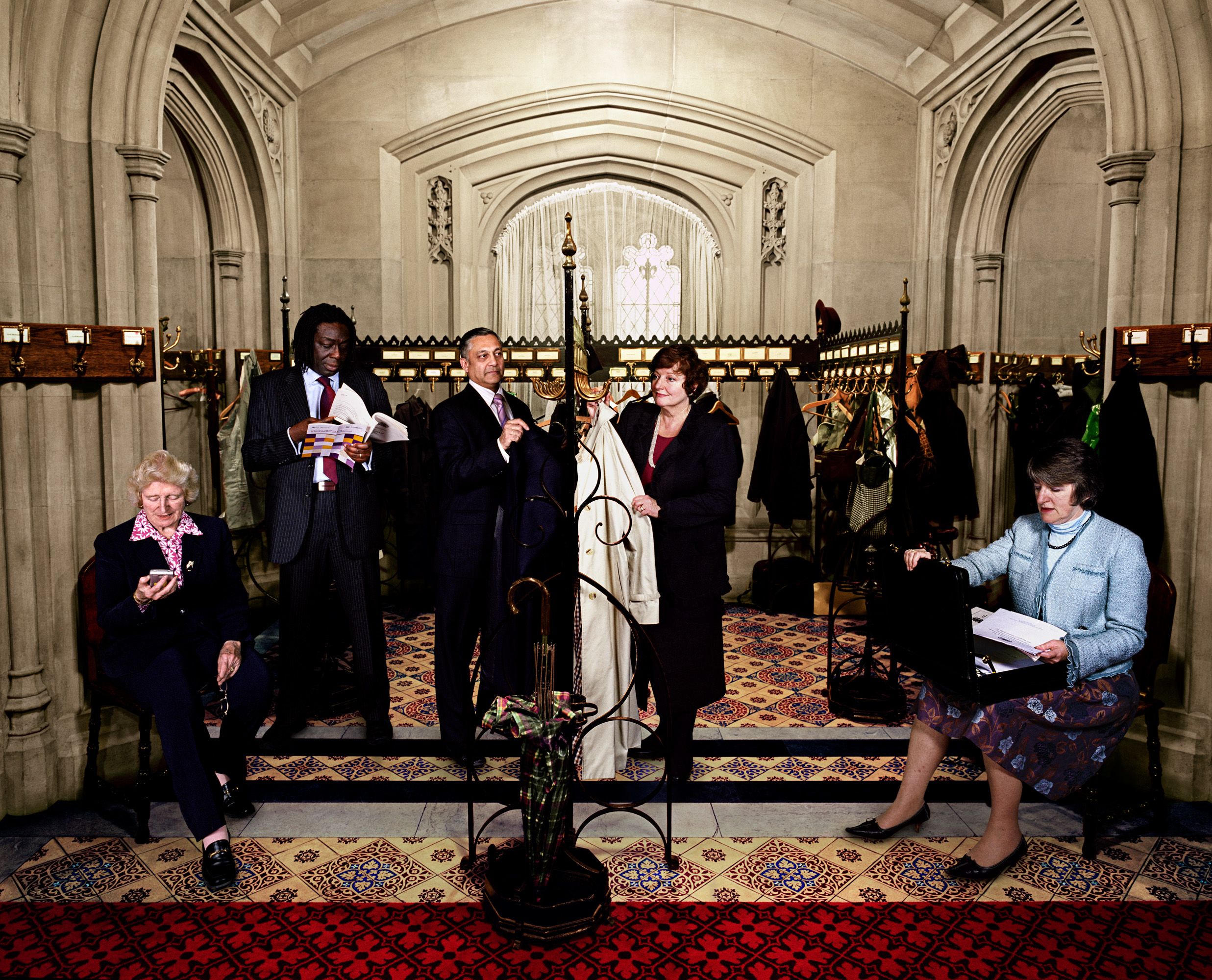
Baroness Finlay of Llandaff
Baroness Finlay is a leader in palliative care, having played a pivotal role in developing the funding formula for Wales to improve cancer care, a world-first funding model. She is a past president of the Royal Society of Medicine, vice president of Marie Curie and was previously chair of the Alcohol Harms Commission.
In the House of Lords, Baroness Finlay campaigns on a number of issues, including improving the care of dying patients, improving the organ donation system and tackling online content on self-harm or suicide.
Baroness Finlay is pictured in the right of this portrait. Here, photographer Desiree Pfeiffer captures five ‘People’s Peers’ informally in the Peers’ Cloakroom in the Palace of Westminster. The Cloakroom still contains many of its original fittings including the hat, coat, and umbrella stands, all designed by Augustus Pugin.
From May 2000, non-party-political members of the House of Lords could be appointed by public nomination or self-nomination. The appointments are made on merit and require a record of significant achievement within their chosen field and the ability to contribute to the work of the House. The media dubbed these ‘People’s Peers.’
People's Peers: Baroness Butler-Sloss, Lord Adebowale, Lord Patel of Bradford, Baroness Muphy and Baroness Finlay of Llandaff, photograph by Desiree Pfeiffer, © UK Parliament, WOA 6914 heritagecollections.parliament.uk
Lord Patel
Lord Patel was a leading medic in the field of high-risk obstetrics prior to joining the House of Lords and was Chancellor of the University of Dundee until 2017.
Born in Tanzania, Lord Patel studied medicine in Dundee before working in hospitals in the city for more than 30 years. In the House of Lords, Lord Patel regularly speaks on issues around healthcare and medicine. He previously chaired the Lords Science and Technology Committee for five years and has served on committees investigating the long-term sustainability of the NHS and the law on assisted dying.
Lord Patel (centre) is pictured here chairing a meeting of the House of Lords Science and Technology Committee.
Photograph by Roger Harris
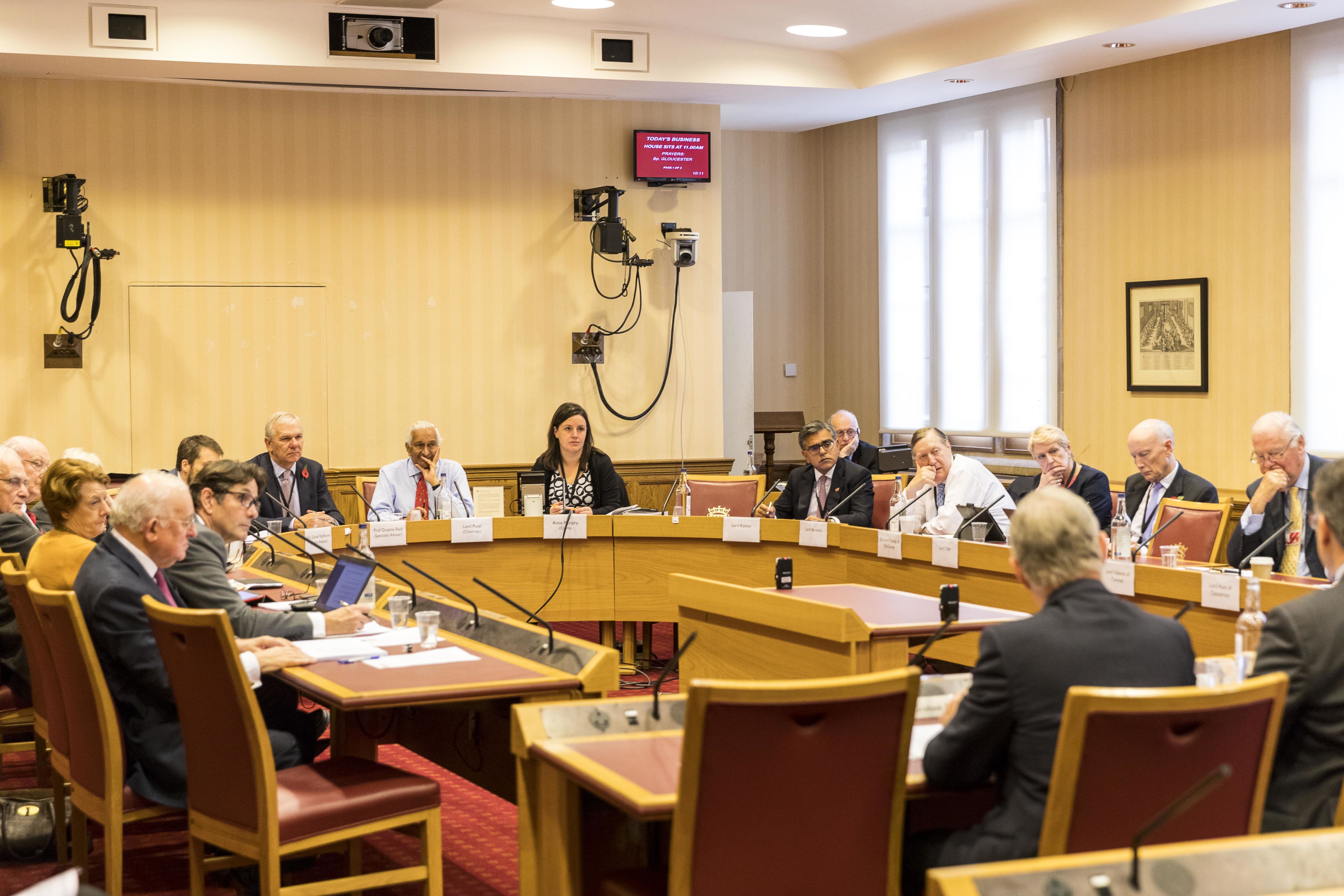
About the Parliamentary Archives
The Parliamentary Archives is the official archive of the House of Commons and House of Lords (UK Parliament).
Photo by Jessica Taylor
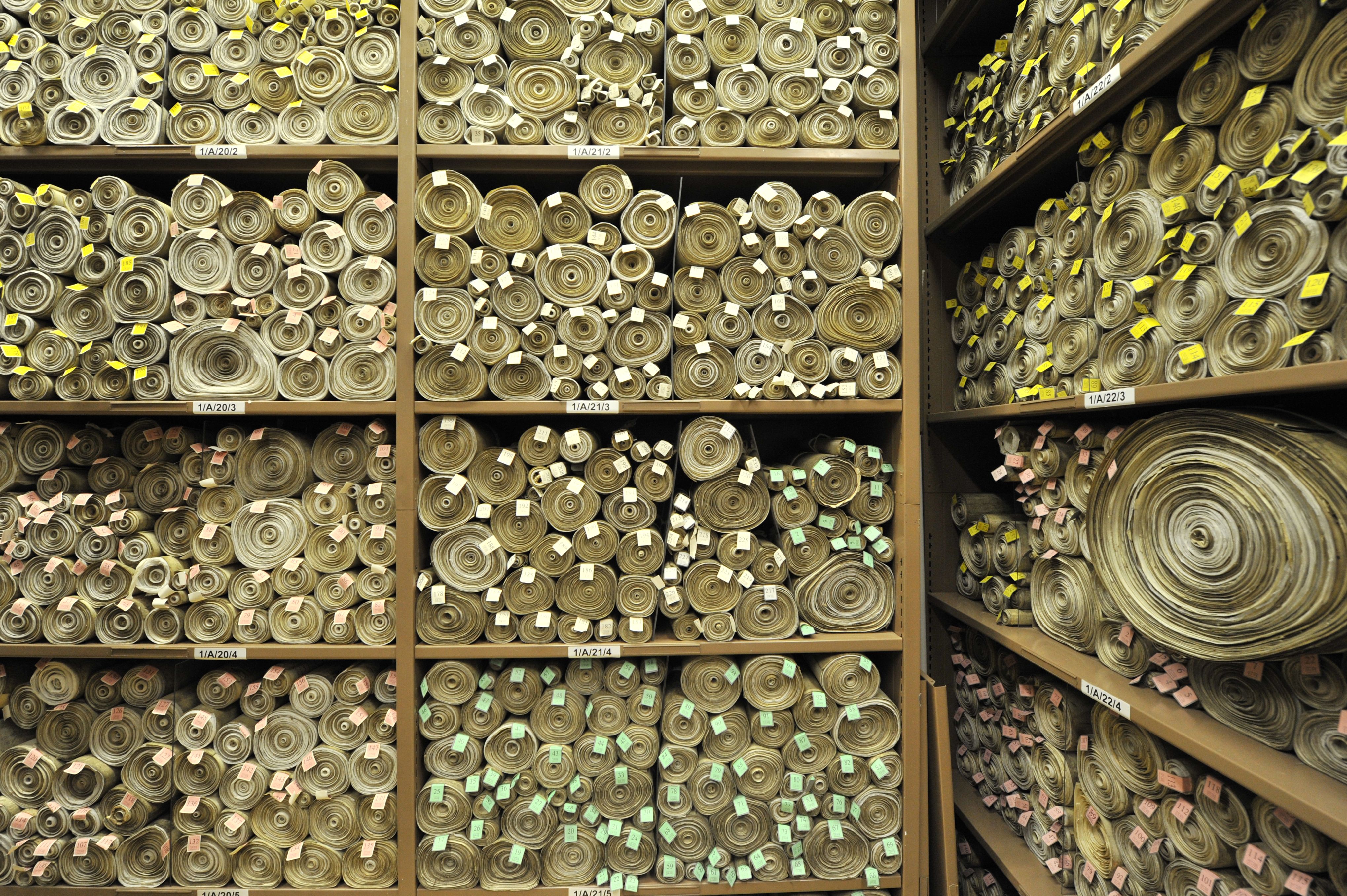
The Archives can trace its origins back to March 1497 when Master Richard Hatton, Clerk of the House of Lords, took the unusual decision to retain sixteen enacted bills. This decision set in motion a quiet revolution in record keeping in the House of Lords, allowing successive Clerks to gradually expand and formalise this process. Record keeping started later in the House of Commons. By 1547 the domestic records of the House were accumulating and a Commons Journal was being preserved.
The two Houses had built up a considerable collection of records by the early 19th century when, on 16 October 1834, a devastating fire took hold of the Palace of Westminster. The House of Commons archive, stored in various locations throughout the Palace, was badly affected. In the aftermath of the fire, plans were put in place to create a dedicated archive store within the re-built Palace. The Victoria Tower at the south end of the estate was purpose built for this role.
Today the Parliamentary Archives continues to look after the records of the Houses of Parliament, providing free public access to the archives. A team of records managers, archivists and conservators work closely with employees of both Houses to capture the digital and paper documents which form the official record of the UK Parliament.
Watch a film with Senior Parliamentary Archivist Mari Takayanagi exploring the first women members of the Lords through the Archives. We also hear from Baroness Grey-Thompson about her work in the Lords.
Find out more about the Archives at archives.parliament.uk
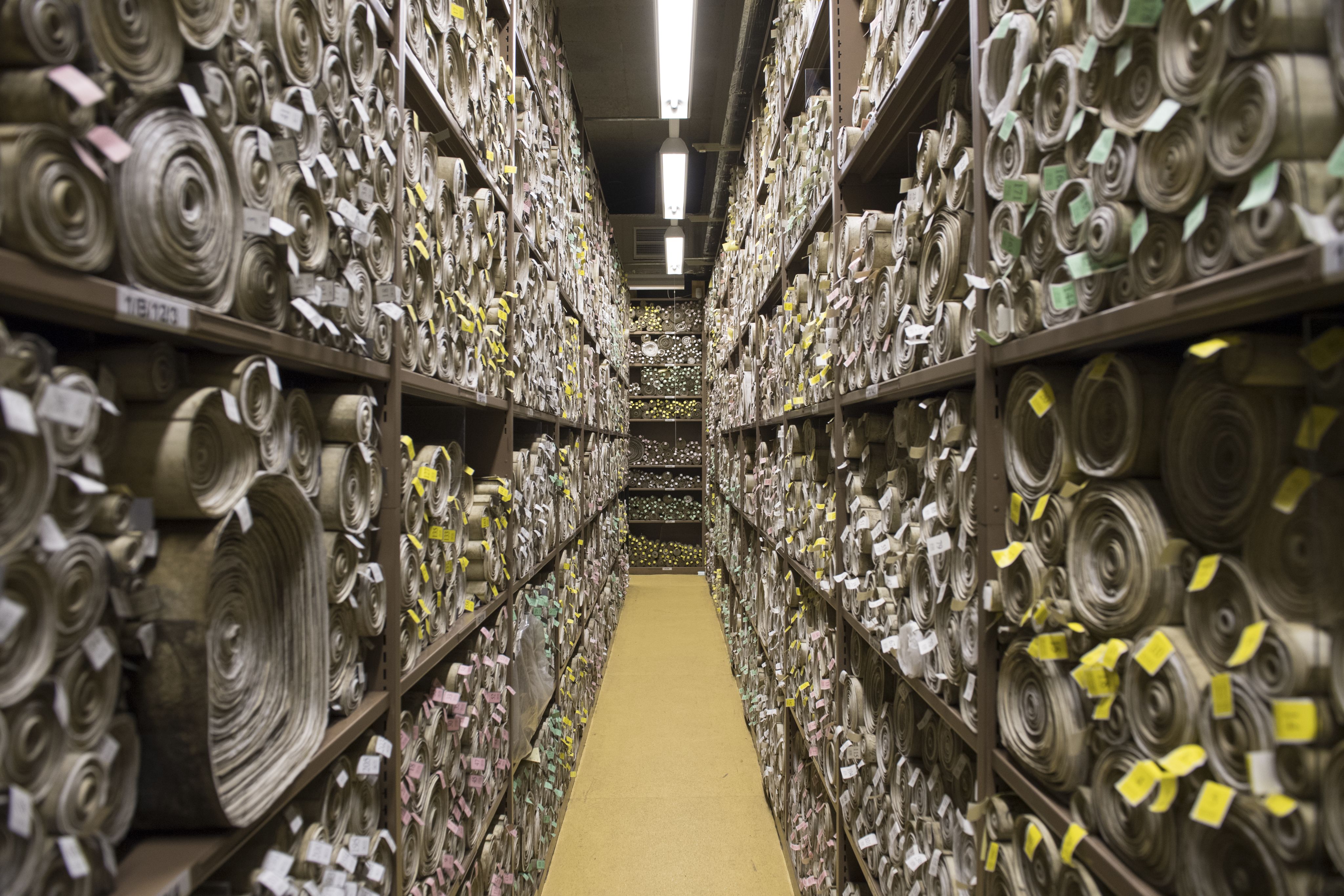
About Parliament's Heritage Collections
Conservation work on frescoes by Daniel Maclise takes place in the Royal Gallery. Photo by Jessica Taylor.
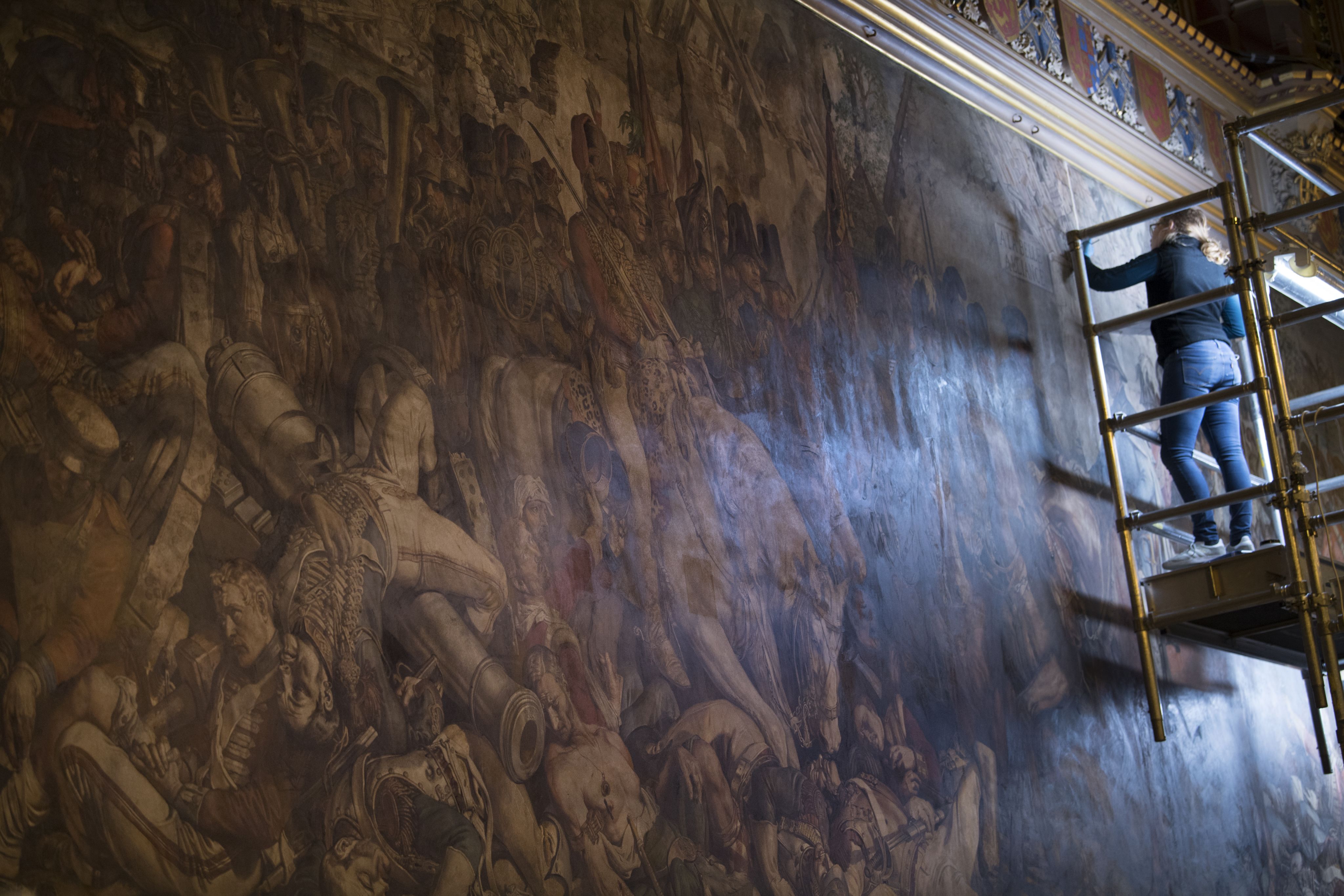
Parliament’s Heritage Collections are home to more than 26,000 objects that help us to understand the history of Parliament and tell its many stories. The unique collections are held within the Palace of Westminster, which is a UNESCO World Heritage Site, and across the wider parliamentary estate.
Parliament’s Heritage Collections contain three distinct collections:
- Parliamentary Art Collection
- Historic Furniture and Decorative Arts Collection
- Architectural Fabric Collection.
Items in the collections date from the 14th century to
the present day. They feature a wide range of forms and mediums, spanning centuries of fine art and craft makers, from archaeological finds to digital art. These are living and working collections, meaning that many objects are in daily use across Parliament’s buildings and spaces, including in the House of Commons and House of Lords chambers.
The collections are cared for by a team of professionals who document, conserve, research, and display the objects within them.
Find out more about the collections at heritagecollections.parliament.uk
Right: Princes Chamber in the House of Lords.
Photo by Annabel Moeller.
